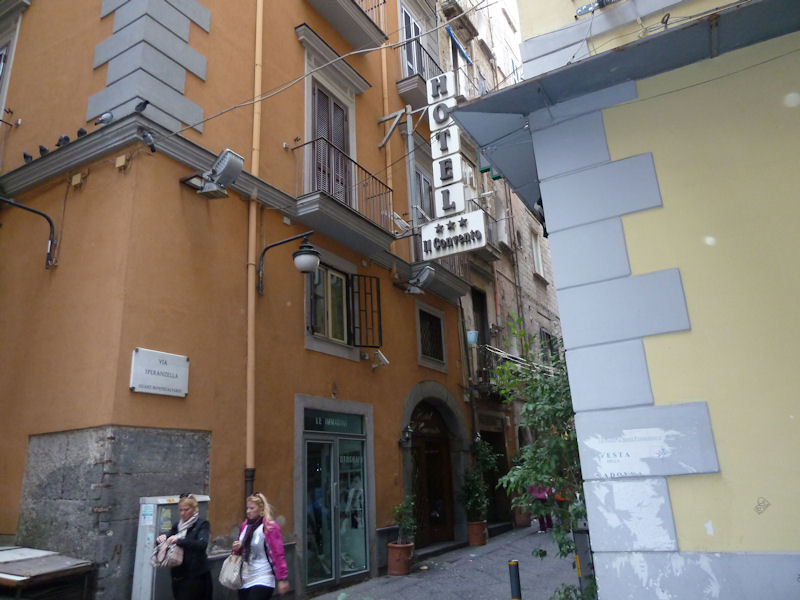You may not find this terribly rewarding unless you're included here, so this is a good time for casual and random browsers to turn back before they get too caught up in the sweep and majesty of the proceedings and can't let go.
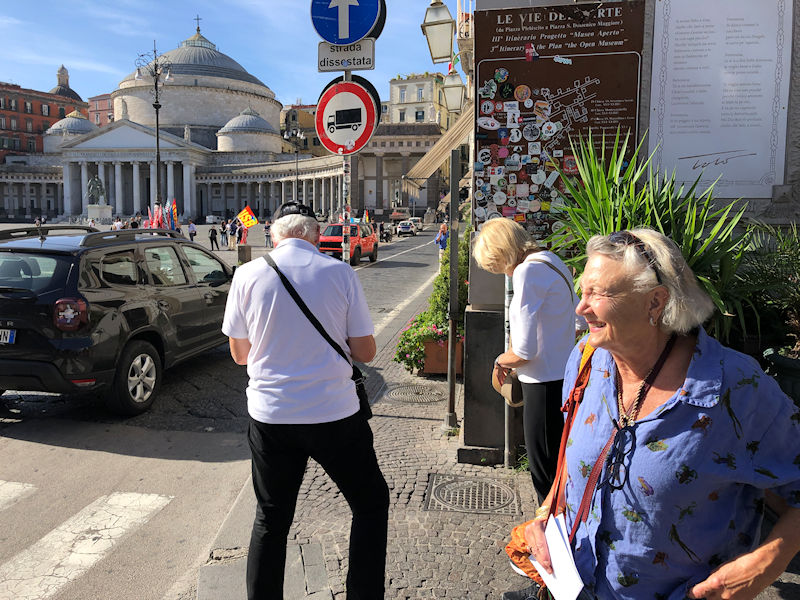
We're off on a fine morning, 30 October 2023, with friends Oscar and Cathy joining us for the day.
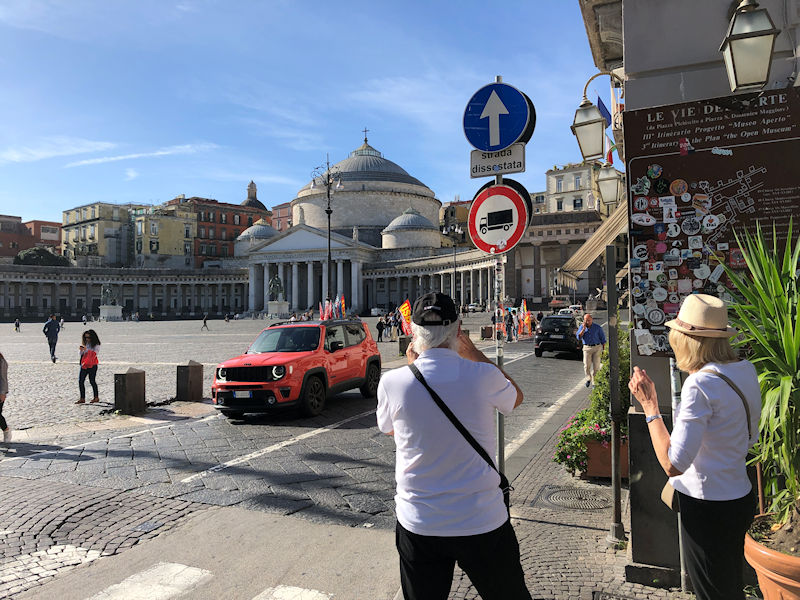
Obligatory picture-taking in the Piazza del Plebiscito
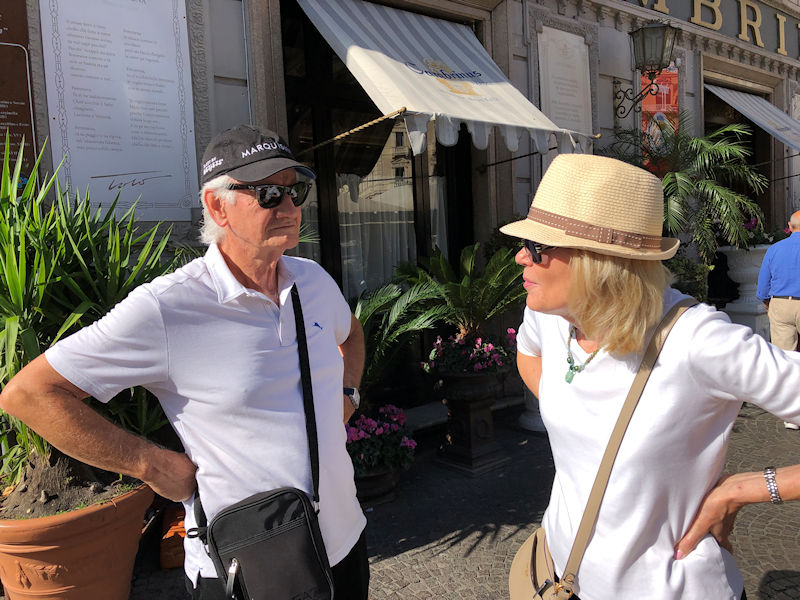
Conversations ensue -- establishing touristic priorities
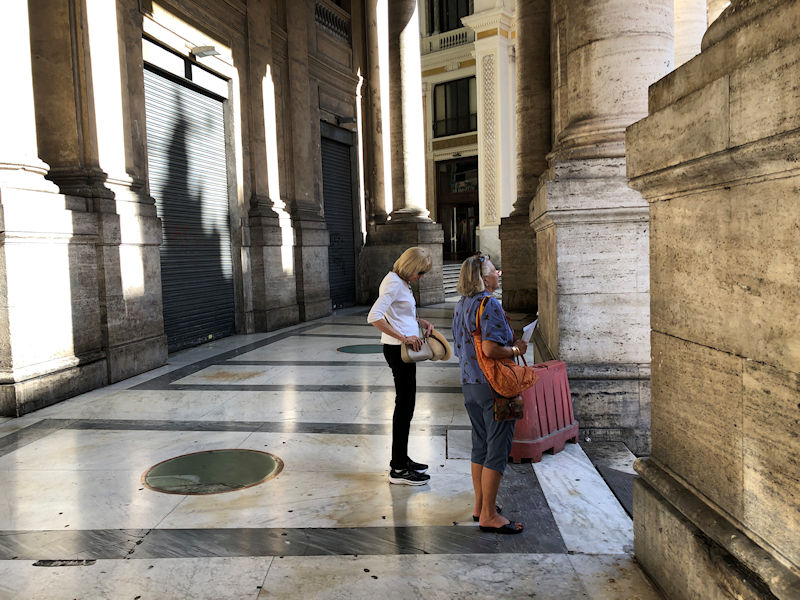
On the porch of the Galleria Umberto I, gazing at . . .
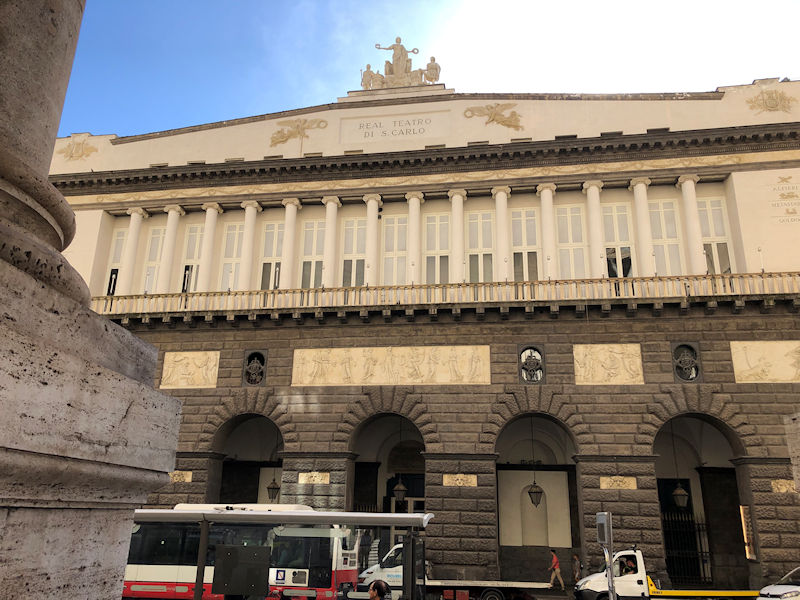
. . . the Teatro di San Carlo
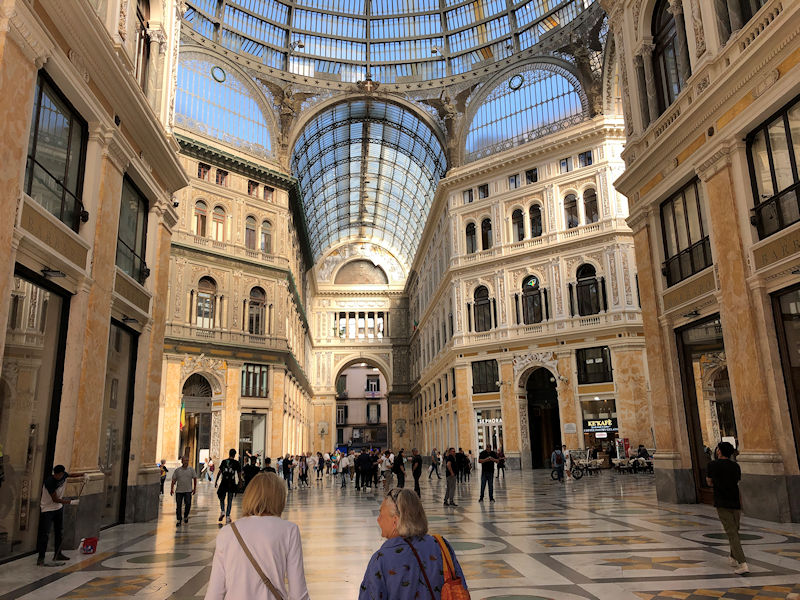
Through the Galleria
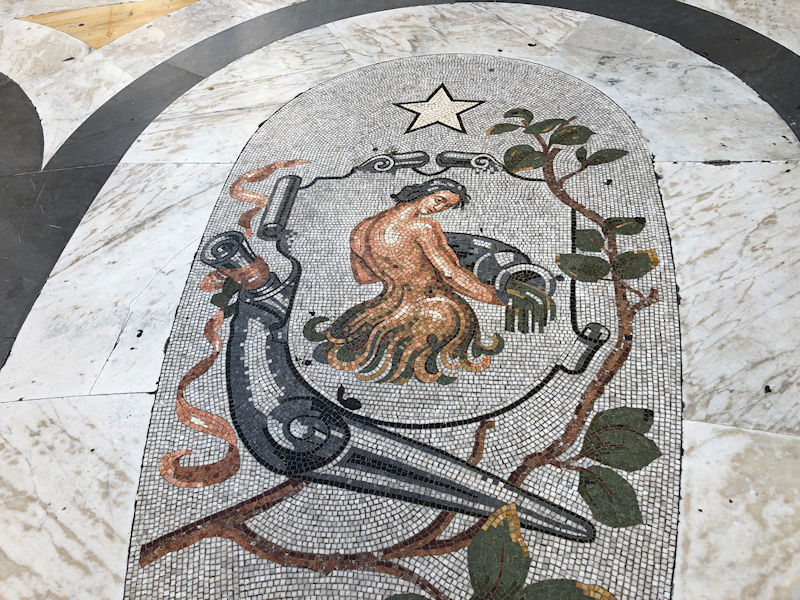
A floor mosaic of a mermaidy/octopus holding a bag of golf clubs. Or something.
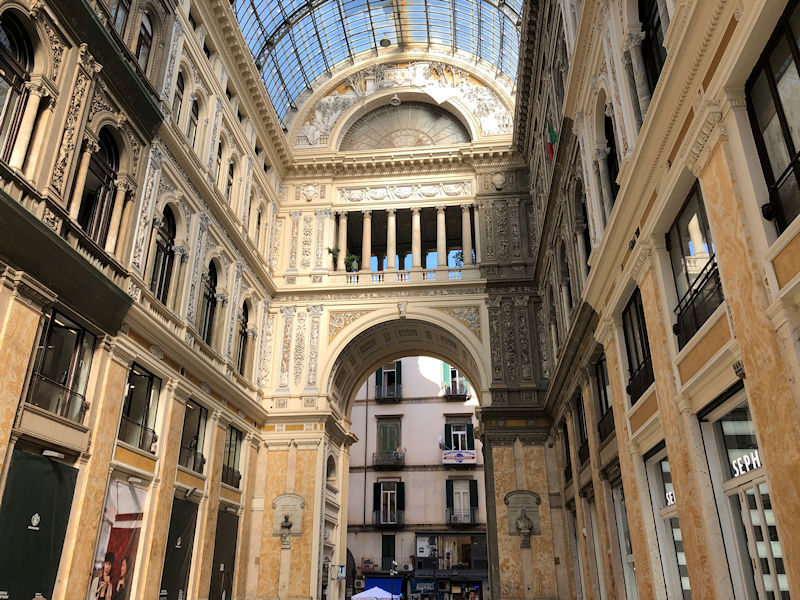
Very elegant for a venerable shopping mall
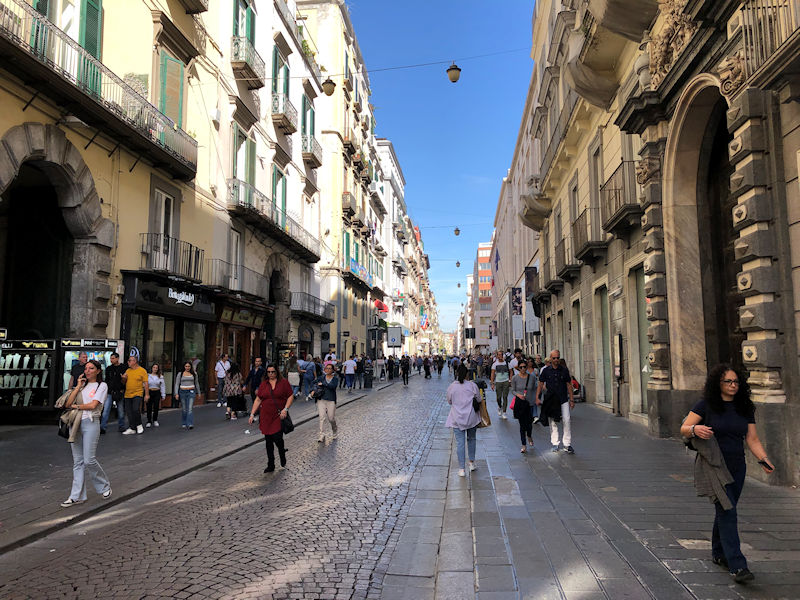
The Via Toledo, awaiting the descent of pedestrian hordes
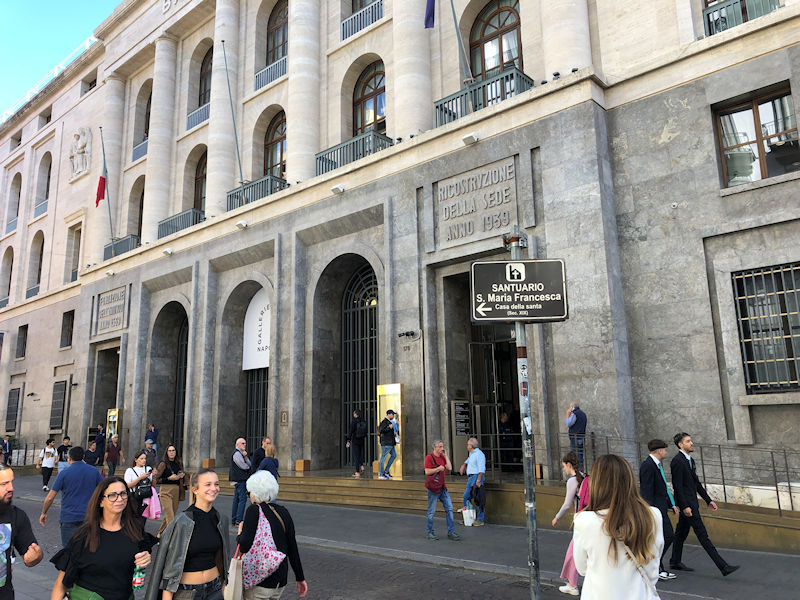
The Gallerie d'Italia - Napoli
The Quartieri Spagnoli
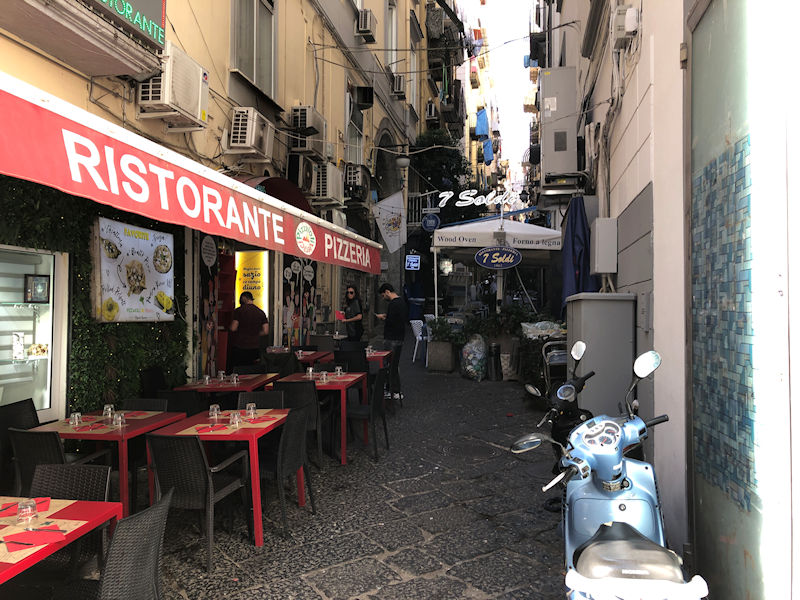
Kristin's been foraging up the side streets and has raced back with good news. We follow . . .
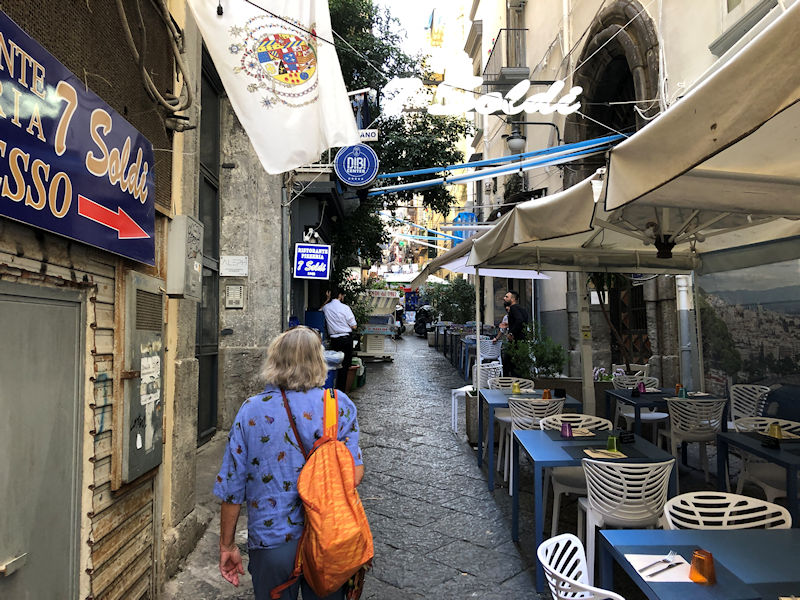
. . . into the crowded Spanish Quarter.
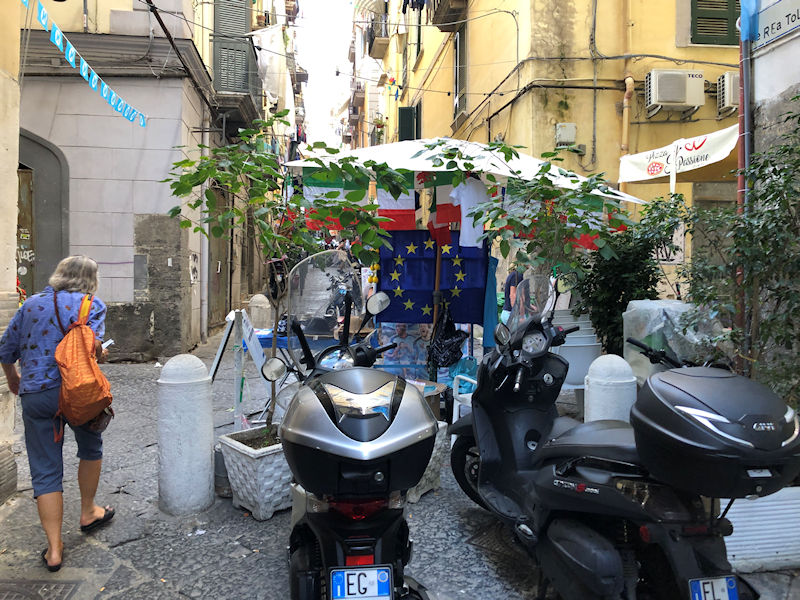
A familiar look to it. That's the Via Speranzella, running parallel to the pedestrian Via Toledo, and . . .
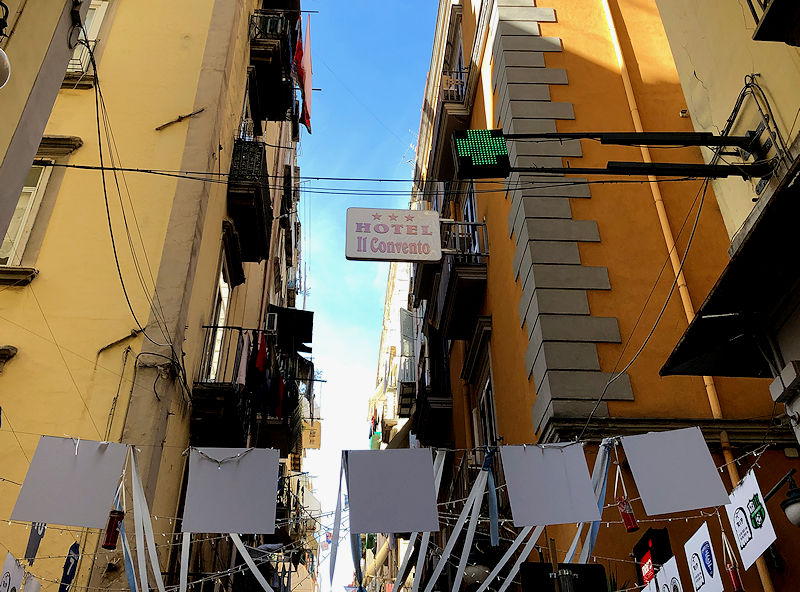
. . . there's the Hotel Il Convento, in which we spent a wonderful week in November 2010 charging out every morning to pace the city or make visits to Pompeii, Herculaneum, Solfarata fumeroles, etc., and dining out in excellent little establishments in the neighborhood. (It was here that I first discovered the glories of Neapolitan Pasta e Fagioli, in the Trattoria Toledo.)
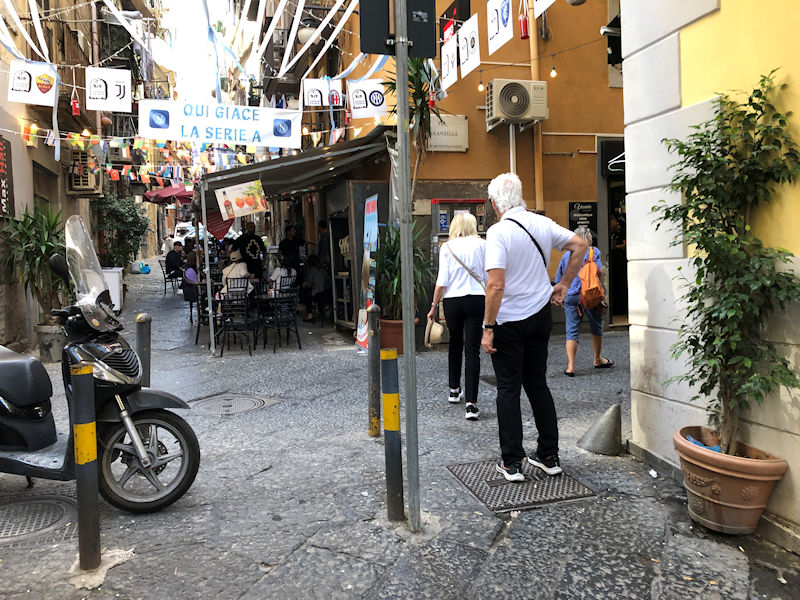
A caption from our 2010 visit: 'The neighborhood, in the Spanish Quarter, was originally the barracks area just outside the old town built for the Spanish garrison troops and their horses in the 16th century. Guidebooks and friends tell us that the Quartieri Spagnoli is too dangerous to stay in, but we found it unthreatening and congenial. One major problem, though: the Via Toledo is pedestrian, so the ubiquitous motor-scooters -- young men, young ladies, old ladies, whole families -- blast through the Via Speranzella at all hours, beeping their little buzzers like an act of religious faith as they zoop through each intersection, and pedestrian tourists need to stay alert.'
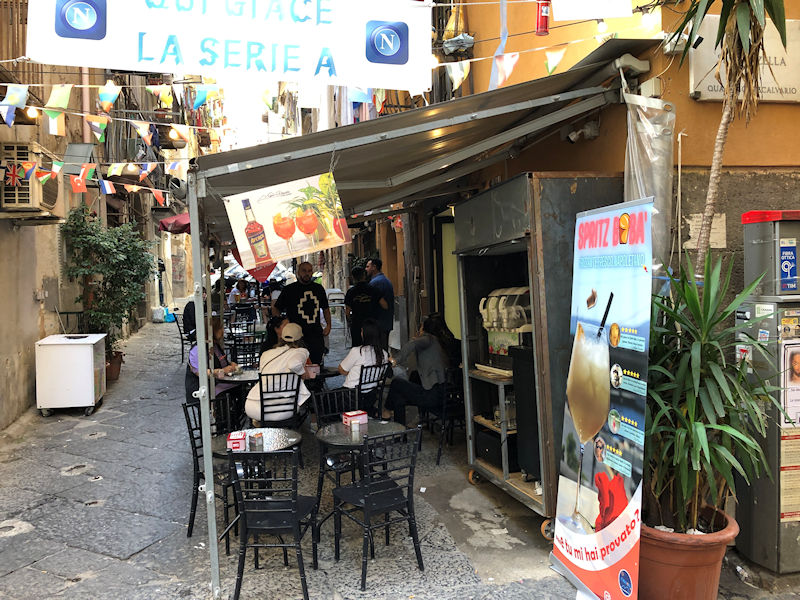
Our room back in 2010 even had its own little terrace on the roof, and a lovely breakfast room, but the WiFi was dodgy.
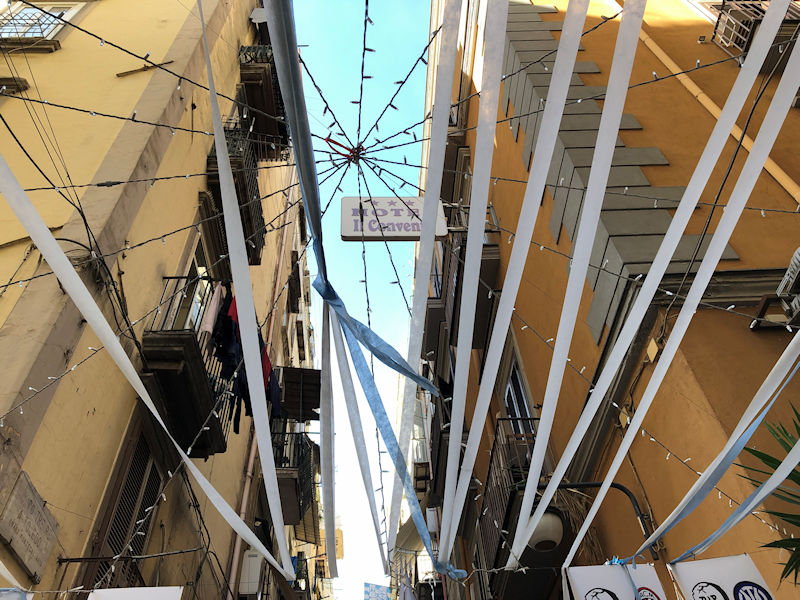
It's a little bit like a homecoming. Not exactly though.
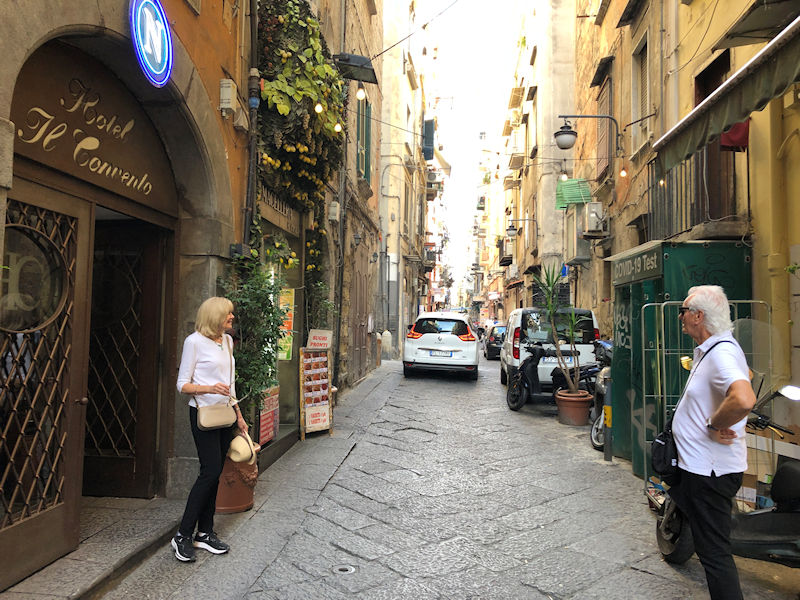
Kristin's inside informing the staff on duty that we once stayed here and liked the place very much.
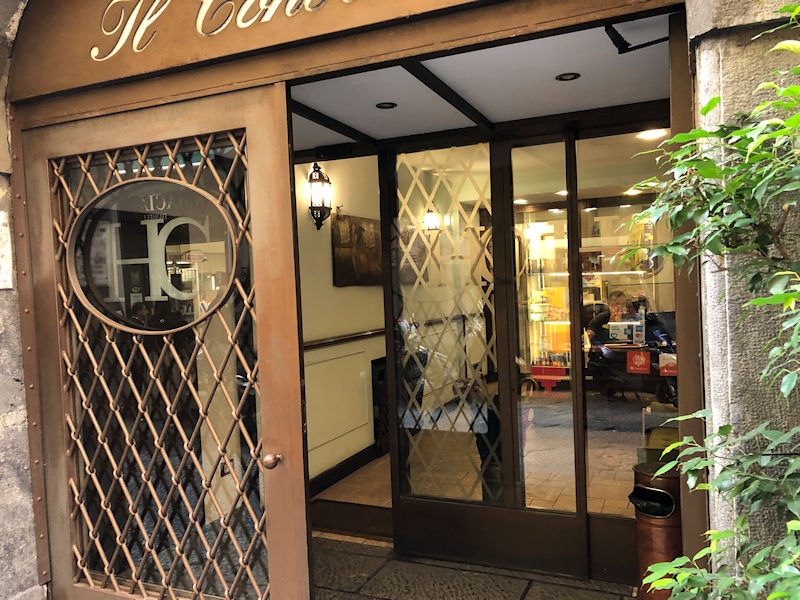
He professed to be gratified.
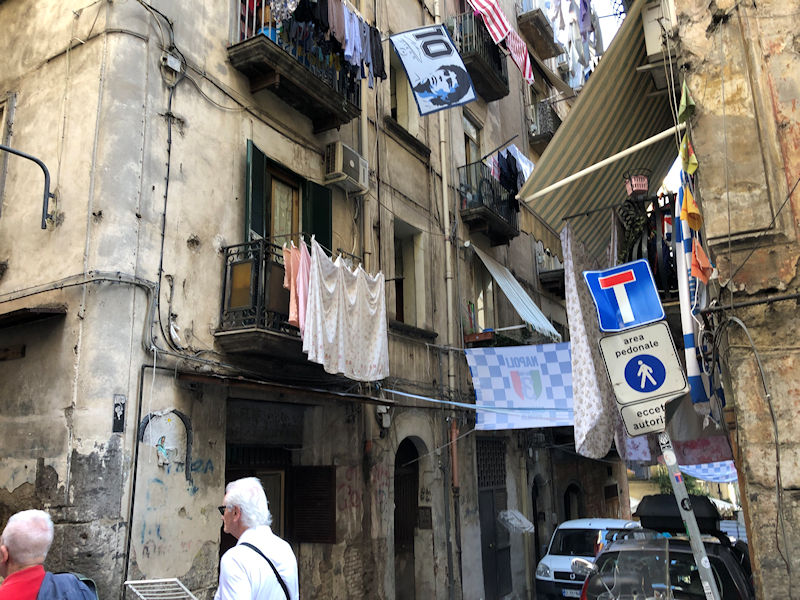
The entire Spanish Quarter is obsessive about the Argentine footballer Maradona, who played for Napoli from 1984 to 1991 and died in 2020. Banners and flags with his picture on festoon every narrow street; there's a stadium just west of town renamed for him after his death.
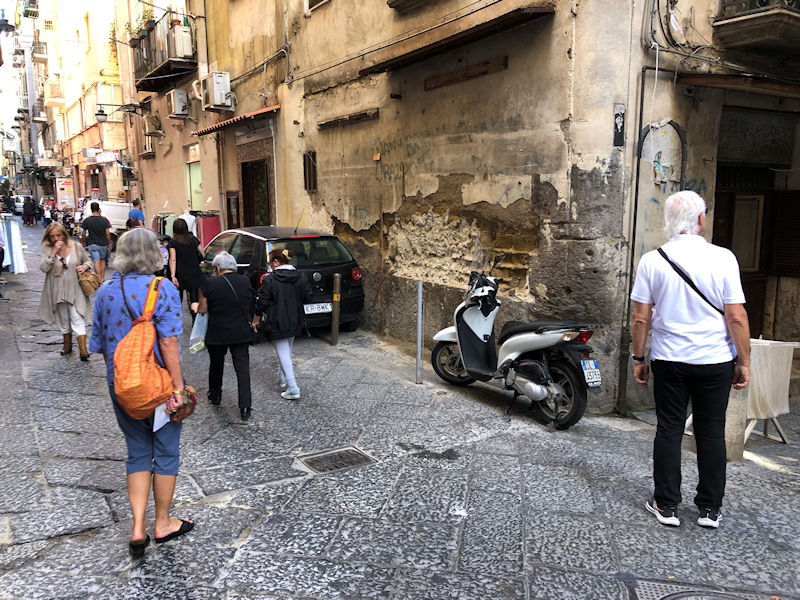
It's a splendid feeling to be wandering about in the Spanish Quarter again, though . . .
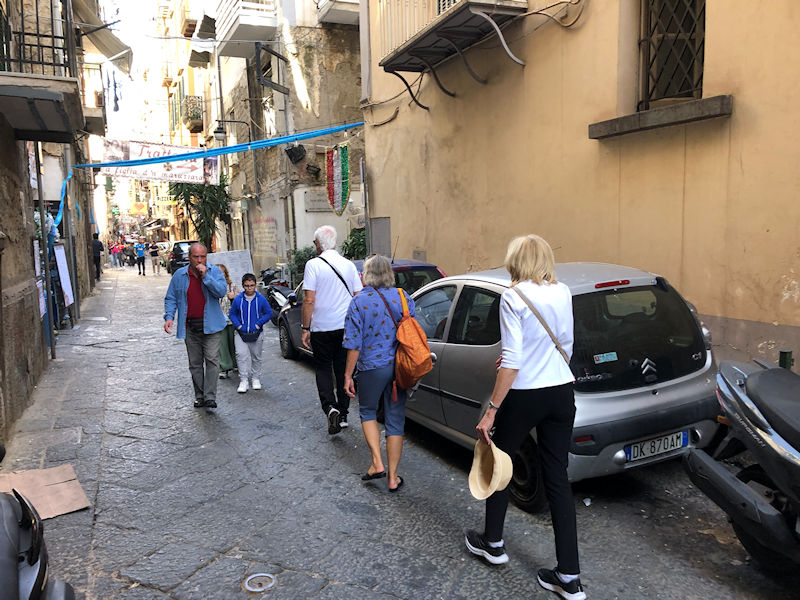
. . . our party by consensus appears to be moving on for grander sights.
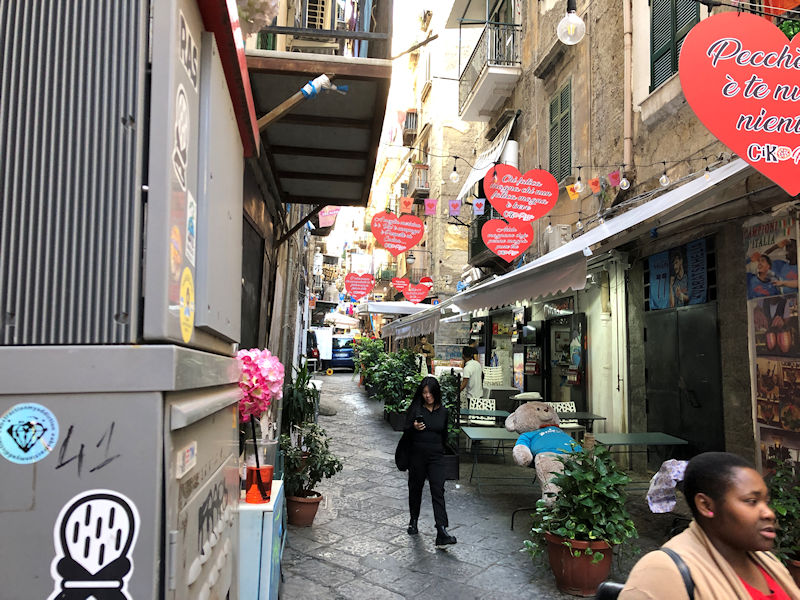
We'll linger behind just a bit to shoot off some memento shots.
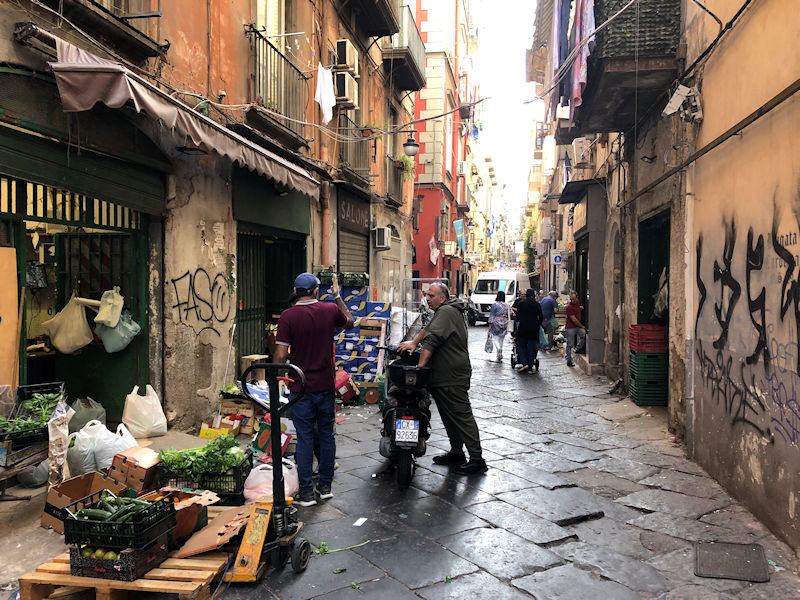
It's a part of this tourism-based city that is generally left to the locals.
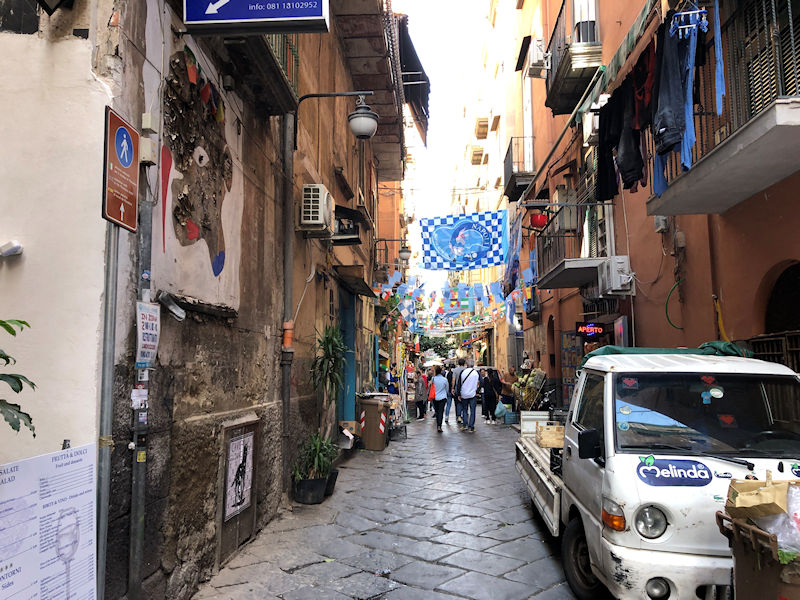
The banners everywhere have to do with the Series A football league, but it's not entirely clear to us whether they are promoting a present championship or celebrating the fact that two years after Maradona joined the bottom-of-the-league local team, Napoli won two first places and two seconds in the Serie A Italian Championships for 1986, '87, '88, and '89.
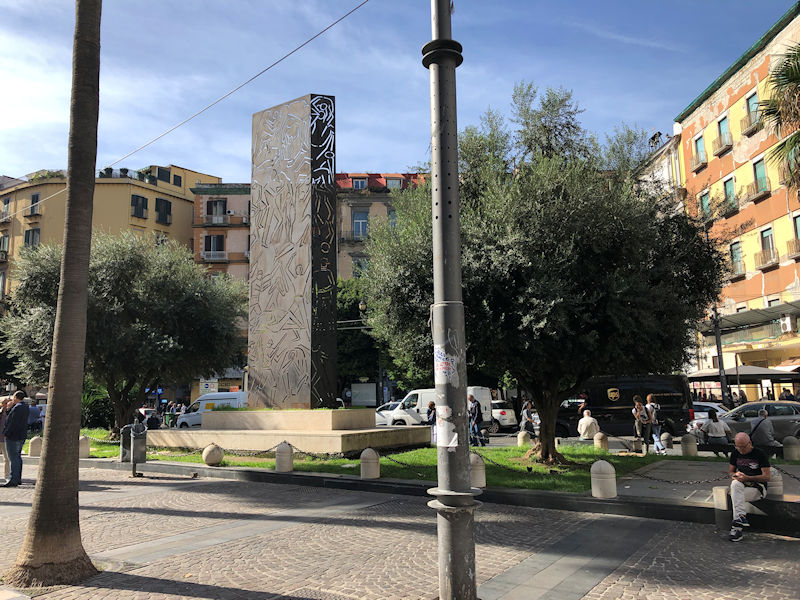
In the Piazza Carità alongside Via Toledo, that's the Monumento a Salvo D'Acquisto; we're branching off here.
Salvo D'Acquisto was a young Carabinieri officer who falsely confessed to sabotage in order to spare the 22 civilians the Germans were preparing to execute if no one took responsibility. The 'sabotage' was actually merely an accident, but he was executed in September 1943 in Fiumicino. A process toward beatification and canonization as a martyr was begun in the 1980s and was almost successful.
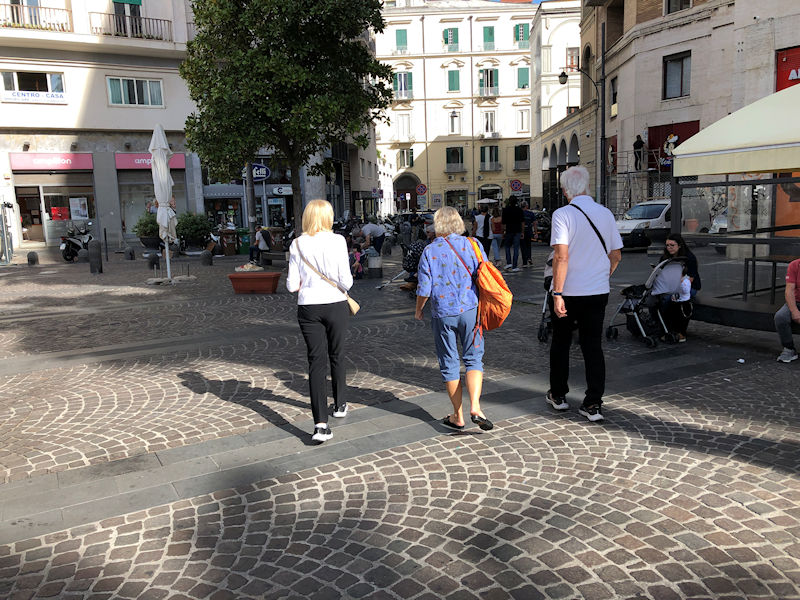
Our first stop, just round the corner in front of us is the Piazza Monteoliveto, featuring . . .
Sant'Anna dei Lombardi
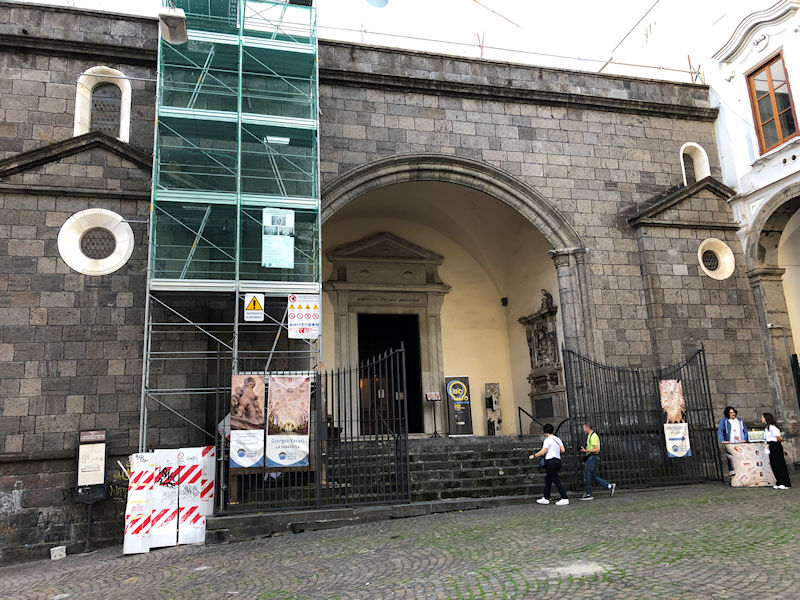
. . . the Monumental Complex of Sant'Anna of the Lombards.
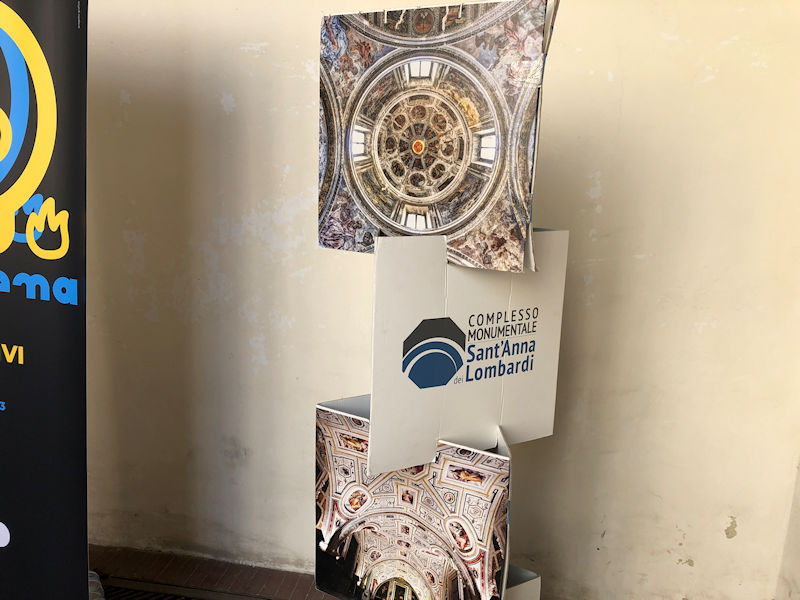
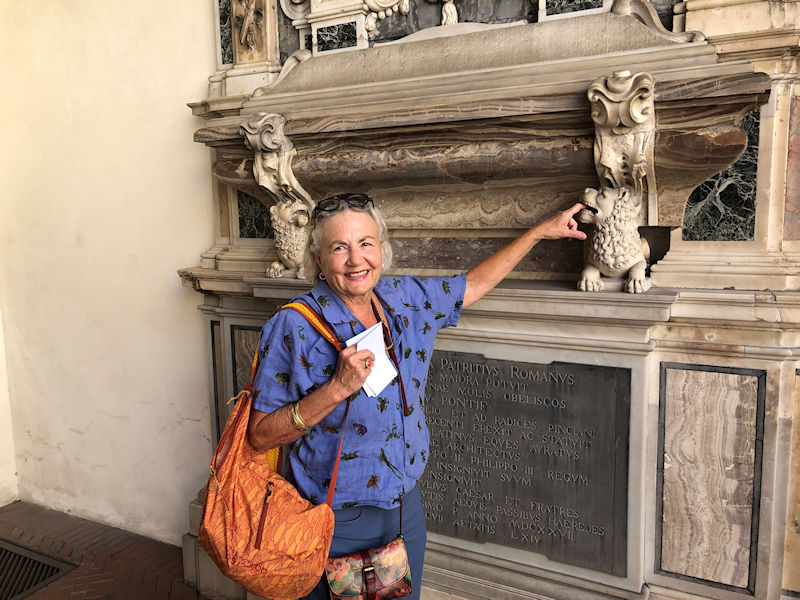
First things first -- hand in lion's mouth.
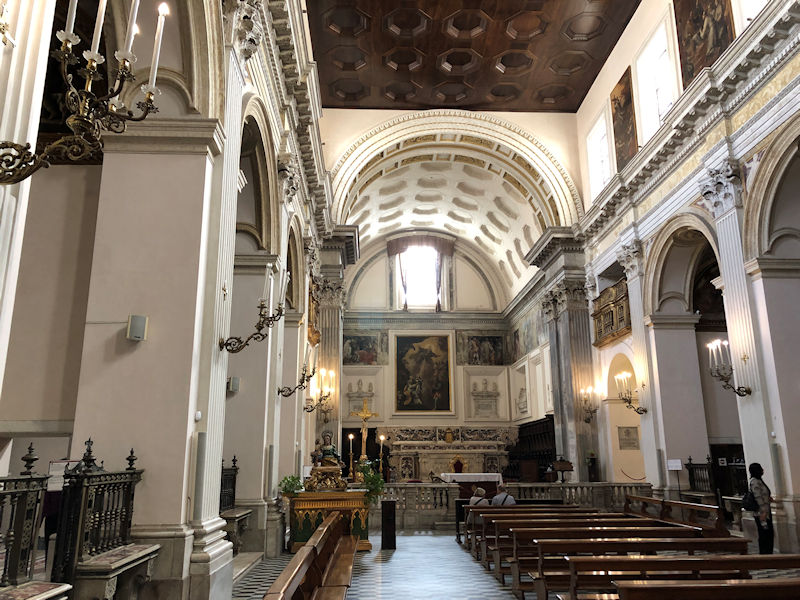
The church part of the complex is interesting -- it has no transept and thus no crossing, just a long rectangle with ten side chapels. It was built in 1411 for the Monastery of Santa Maria di Monte Oliveto and operated by the Benedictine Order of Olivetans. It was favored by the Spanish notables in town, and there were reconstructions made in 1581 and again in the 17th century. The church is still sometimes referred to as the Church of Monteoliveto.
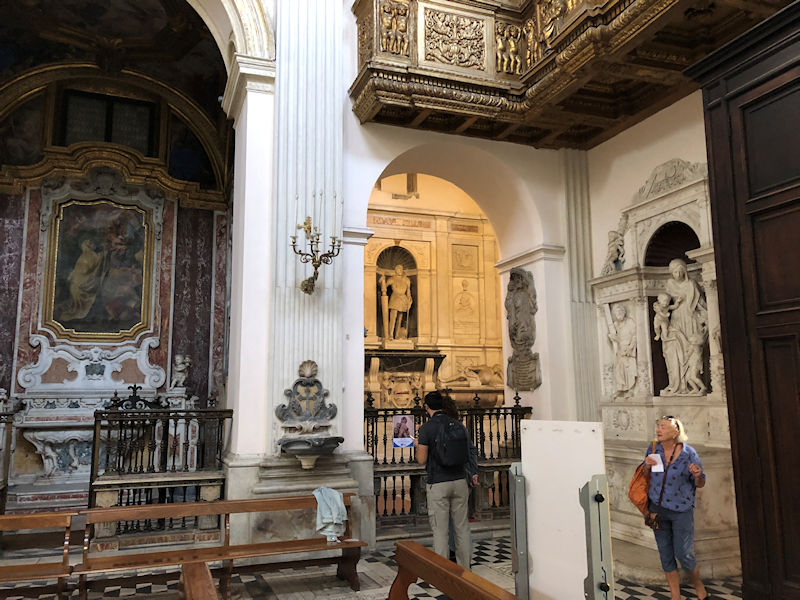
In 1798, however, the Olivetan order was suppressed and the complex reverted to the state. The king then sold it to the lay Arch-Confraternity of Lombardi which had just lost its own church dedicated to St Anne, the mother of the Virgin Mary described in the apocrypha and in traditions, though not in the Gospels. Thus it was formally renamed, in effect, the Church of St Anne of the Lombards' Confraternity, the charitable association of those presumably with Lombard heritage. The complex was no longer a monastery.
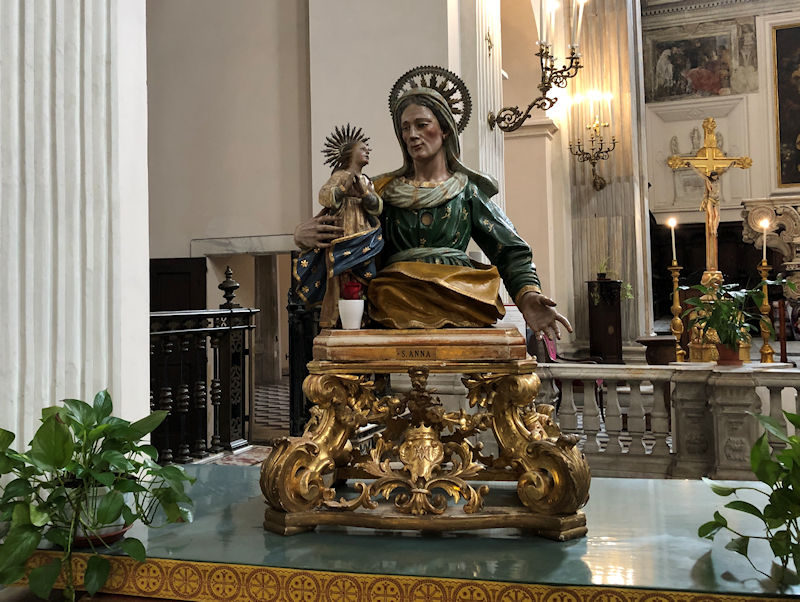
That's St Anne, and cute little Mary (actually, it's just the top half of St Anne)
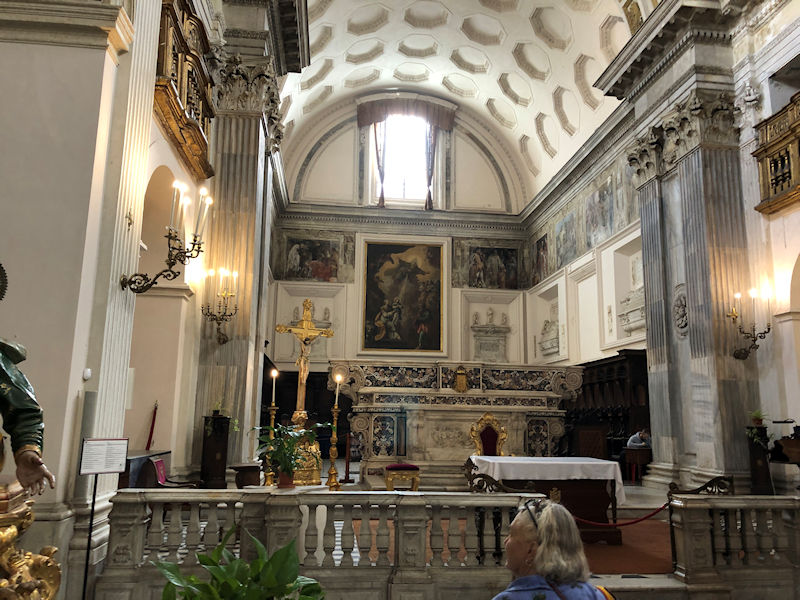
Here's the main altar. There are an enormous number of interesting frescos here, though few of the artists are now familiar to the general public (like us). The sacristy does include frescoes by Giorgio Vasari, who came to Naples to work on them in 1544, and there were apparently three Caravaggios, all of which were destroyed when an earthquake hit the church in 1805.
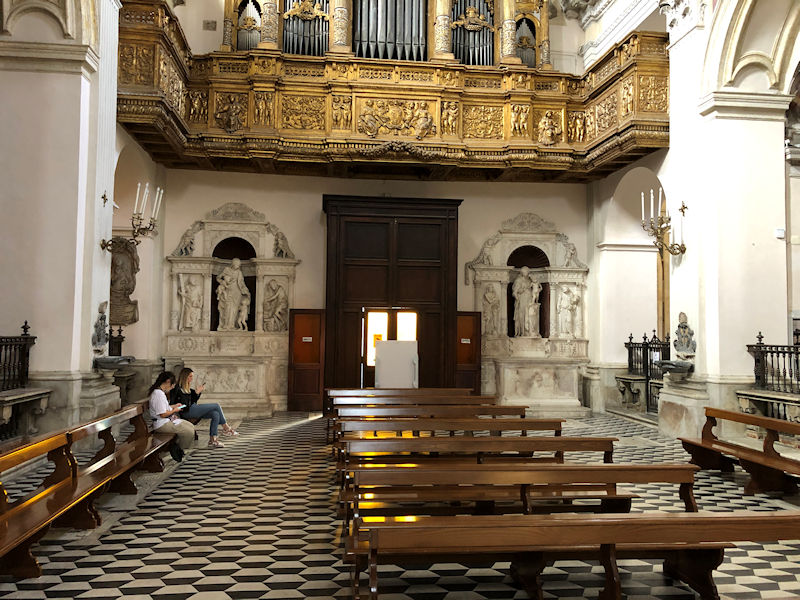
The entrance with organ overhead. This church and monastery were outside of the city when they were first built, but in later years the city has absorbed it, in the 16th century, and then swallowed it up to some extent. This was once one of the largest monasteries in Italy, but now the large building just outside that door has become a Comando Provinciale Napoli of the Carabinieri, with a manicure salon facing the street, and the huge cloister at the far end, with some other bits and bobs, has been spared demolition but is incorporated into the complex of the Palazzo delle Poste, the main city post office, completed in 1936 in a horrific fascist-era style.
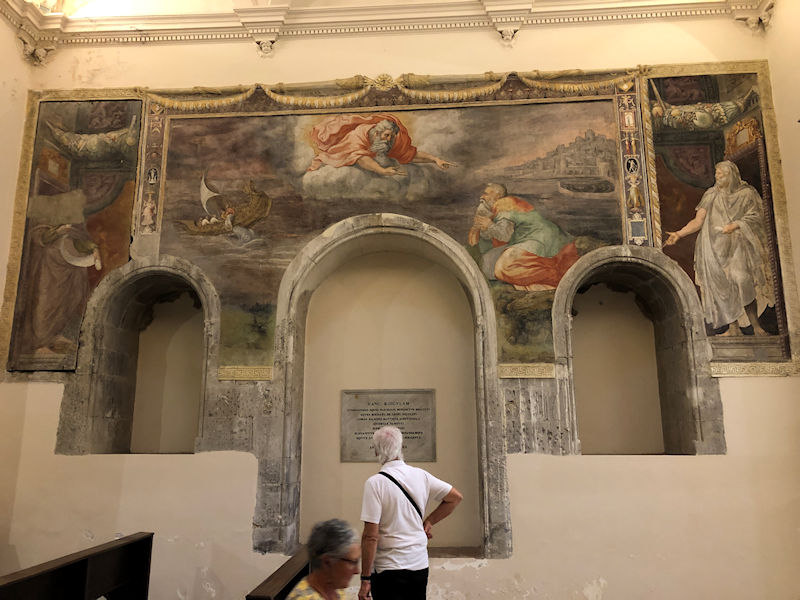
The shrine of the niches of stolen saint statues. And Oscar.
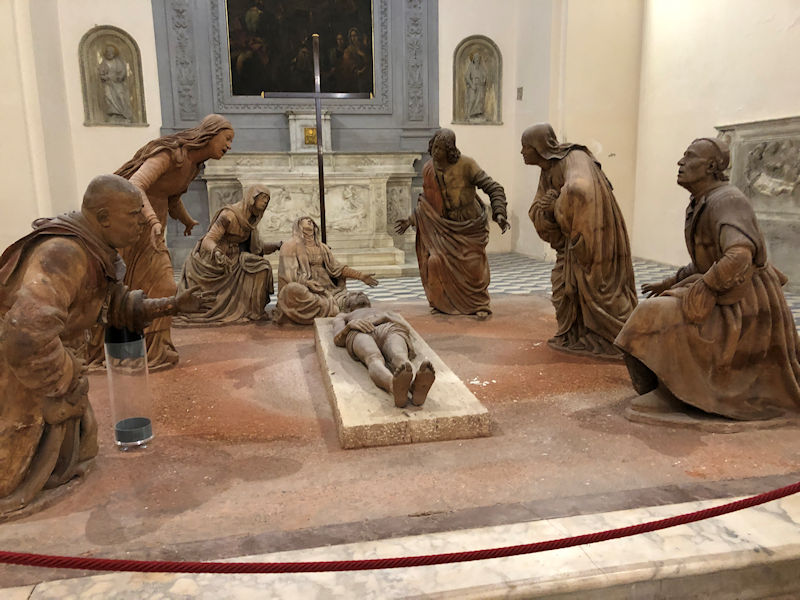
'Undisputed masterpiece of Renaissance sculpture, the 'Lamentation over the Dead Christ' was made by the Modena-based artist Guido Mazzoni in 1492.' The figures are identified (left to right) as Joseph of Arimathea, Mary Magdalene, Mary Salome who holds a fainting Virgin Mary, St John the Evangelist, Mary of Clopas, and Nicodemus.
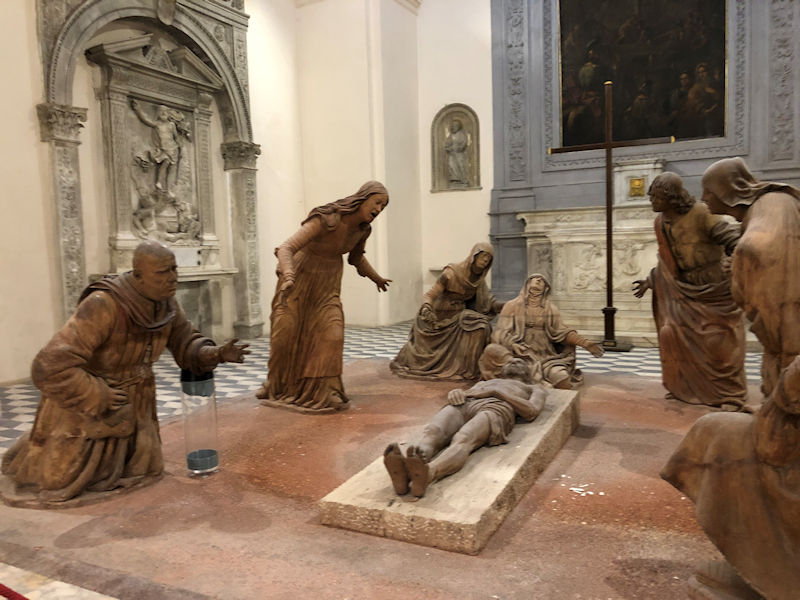
It's a terra cotta masterpiece, this Compianto sul Cristo morto, as good as or better than our previous Lamentation blue-ribbon winner in Asti, here (2014) and here (2018).
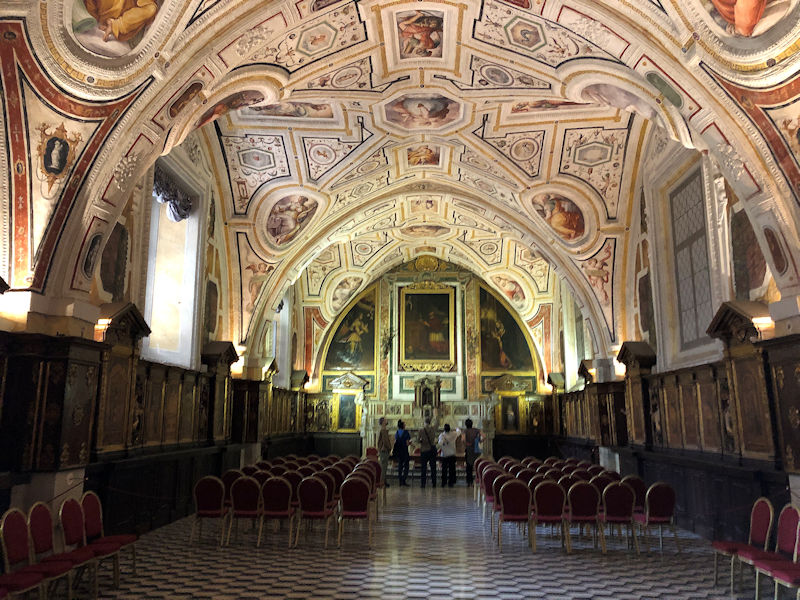
The 'Sacristy of Vasari' is reached by a passageway through the Fiodo Chapel. The sacristy has Tuscan Renaissance style frescoes painted by Giorgio Vasari, as well as wooden stalls decorated with wooden inlay (1506–10) by Fra Giovanni da Verona.
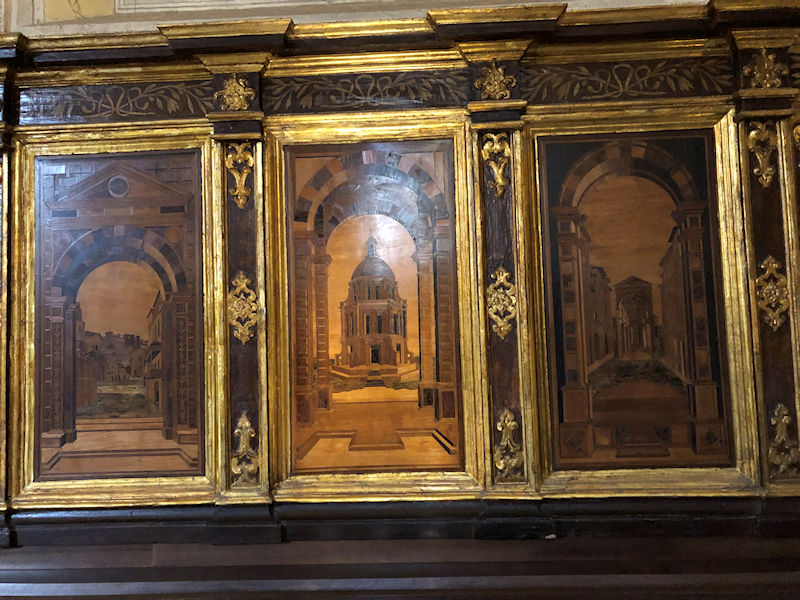
A few of the intarsia or inlay panels by Fra Giovanni
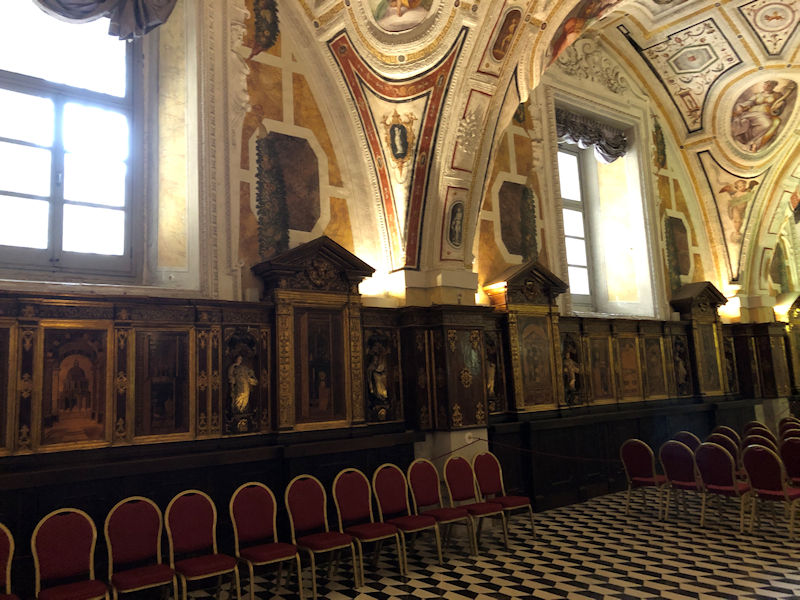
And a lot more of them.
[The best intarsia work we've seen is in the Montefeltro ducal palace in Urbino. Here's an example.]
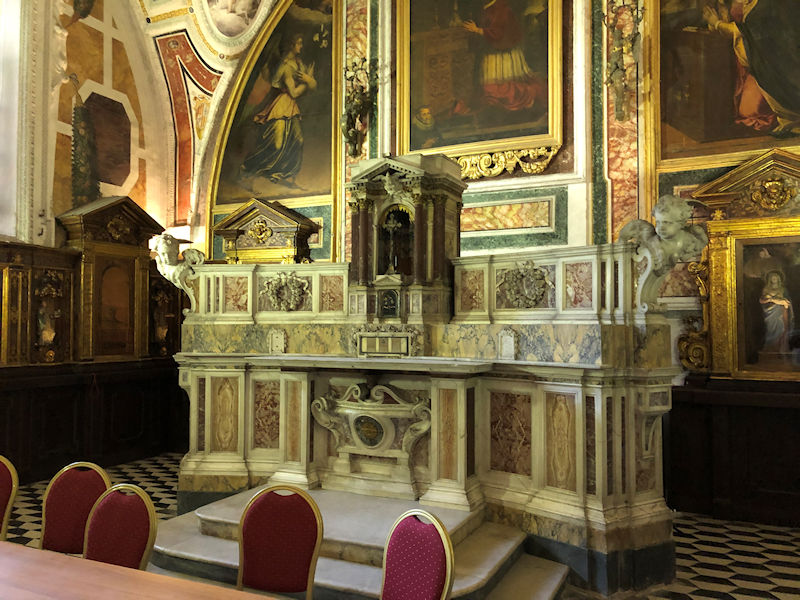
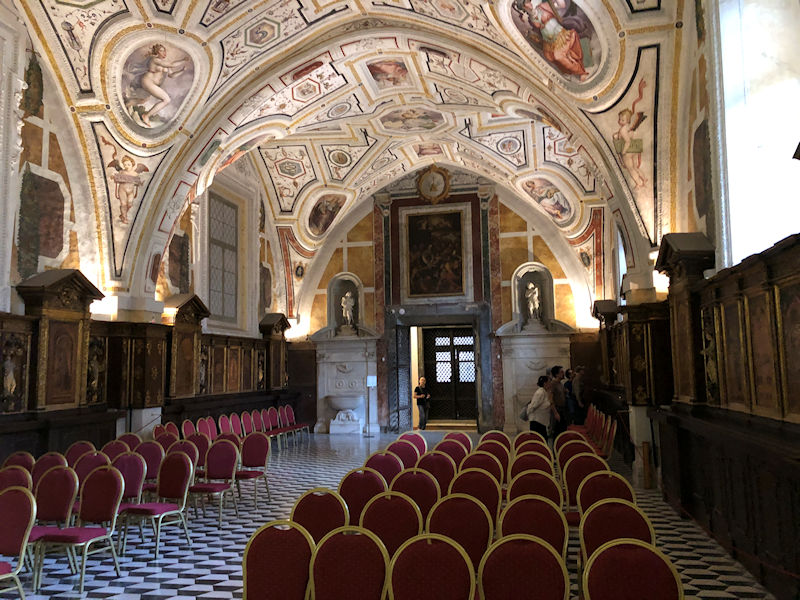
The complex's website describes this room as 'A small Sistine Chapel in the middle of Naples'.
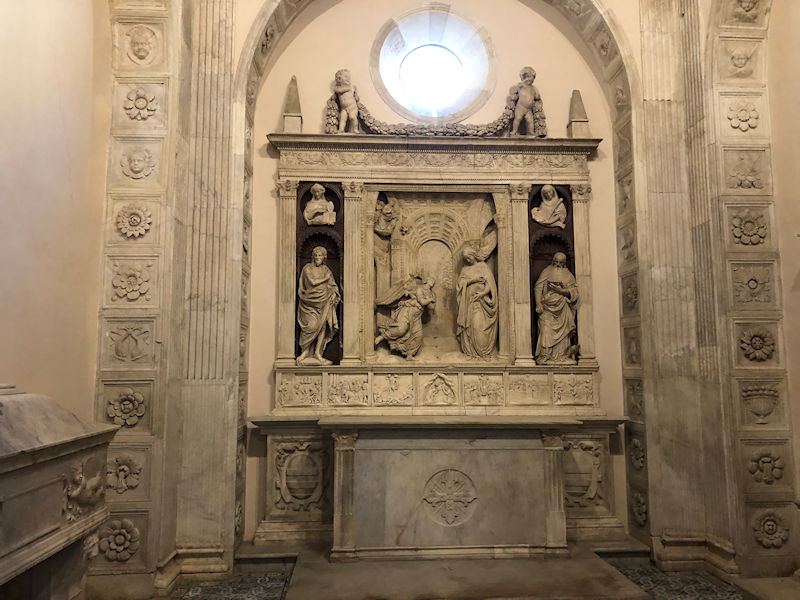
One of the side chapels
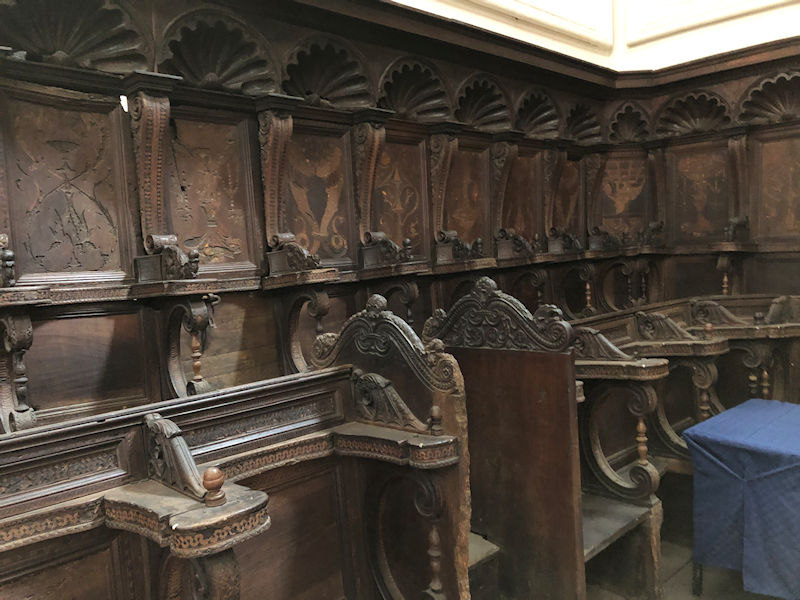
The choir round behind the main altar. These decorated choirs always look so beautiful, though sitting on them for more than ten minutes must have been a kind of penitential sentence, like 'say 800 Hail Marys'.
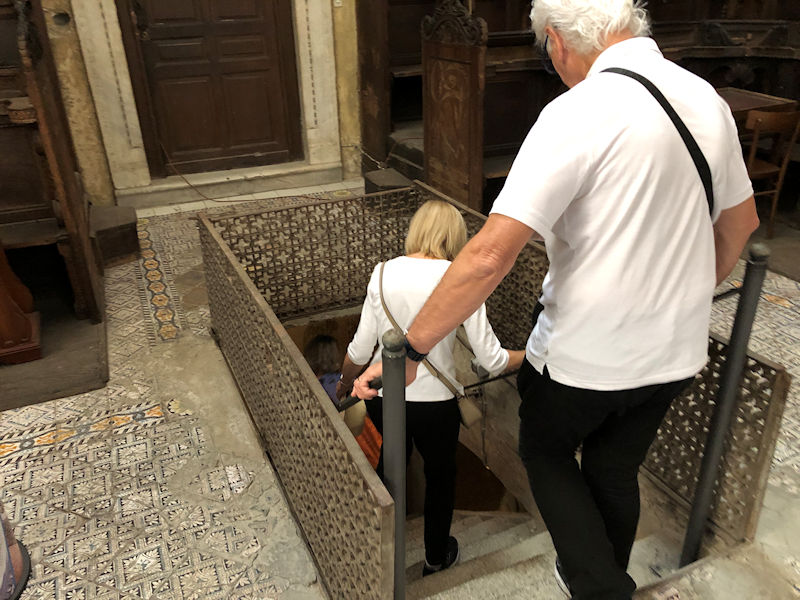
The Descent into the Underworld (crypts are always such fun!)
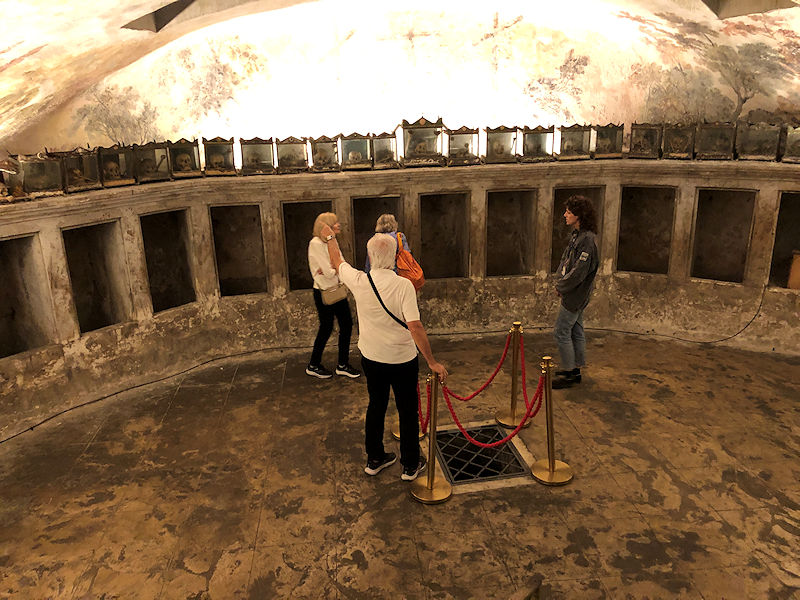
We're underneath the main altar now. The complex's website refers to this as the Hypogeal, i.e., the Subterranean, and as the 'Abbot's Crypt' from the time when this was an Olivetan monastery. That blast of inspired light near the roof is actually a fairly worthy Calvary scene and some enchanted forest scenes round the sides, but the crypty lighting is not conducive to seeing anything in a photo.
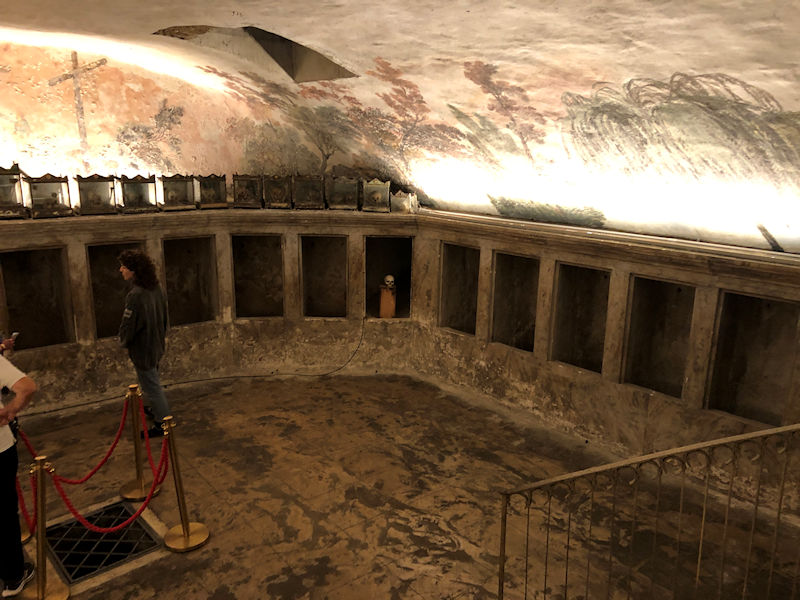
The knowledgeable docent is explaining the purpose of all the scolatoi, or draining holes, for the burial of the dead abbots 'through the practice of 'scolatura' (draining). Oh man. That cordoned-off hole in the floor is part of that process.
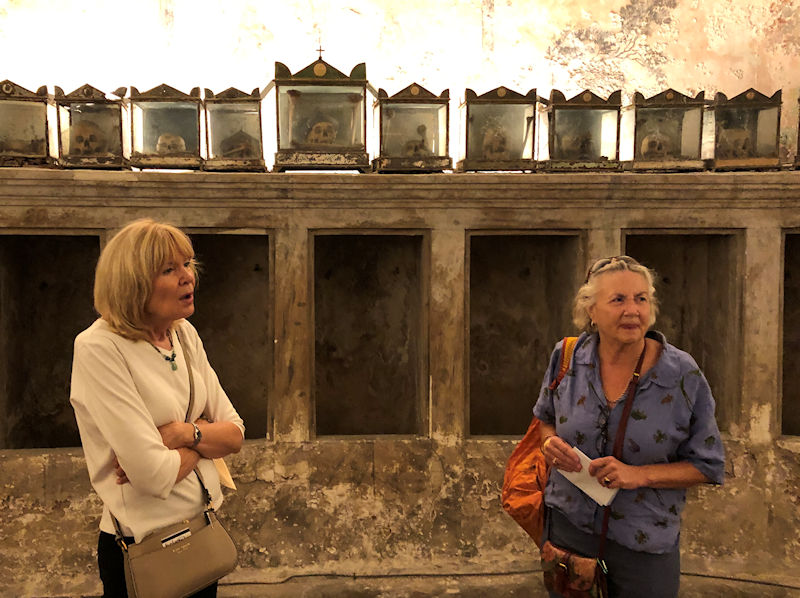
There's something about crypts that evokes more and more questions for the guide.
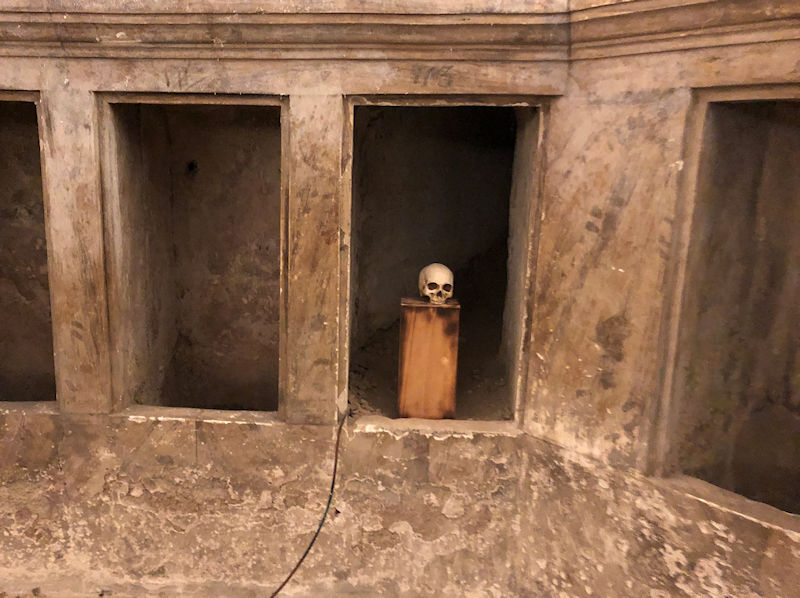
Somebody got left behind. As a memento mori, why not?
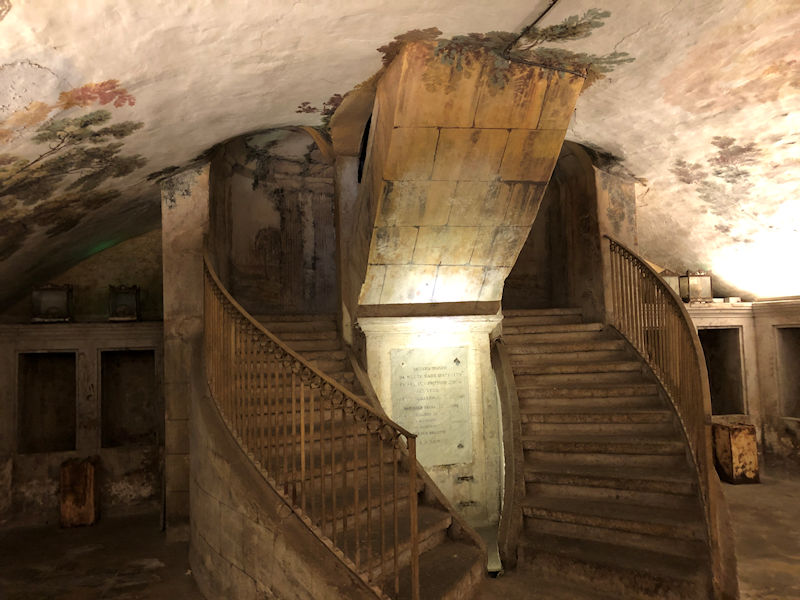
The website points out that this draining factory is 'made elegant by the grand Imperial staircase'.
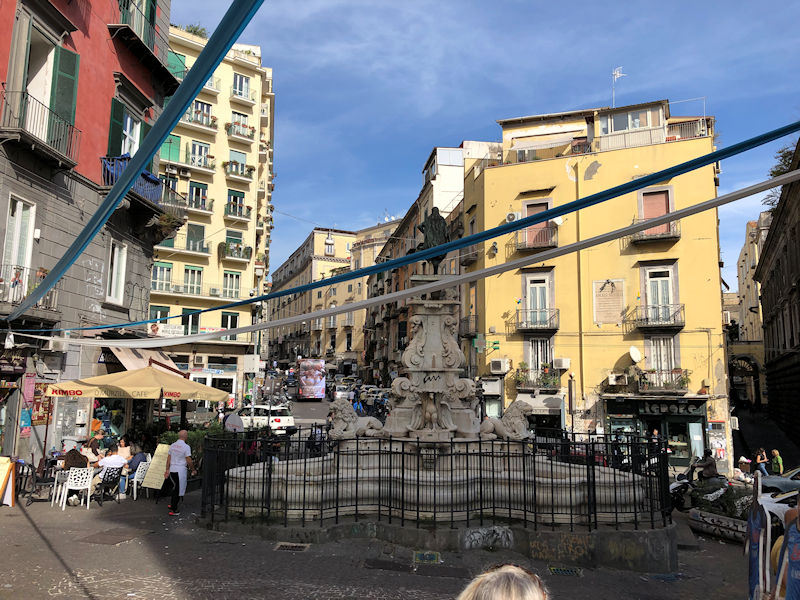
Just outside, facing the Via Monteoliveto, that's the Fontana di Monteoliveto, completed in 1699, with a bronze statue of Charles II of Spain sticking out the top.
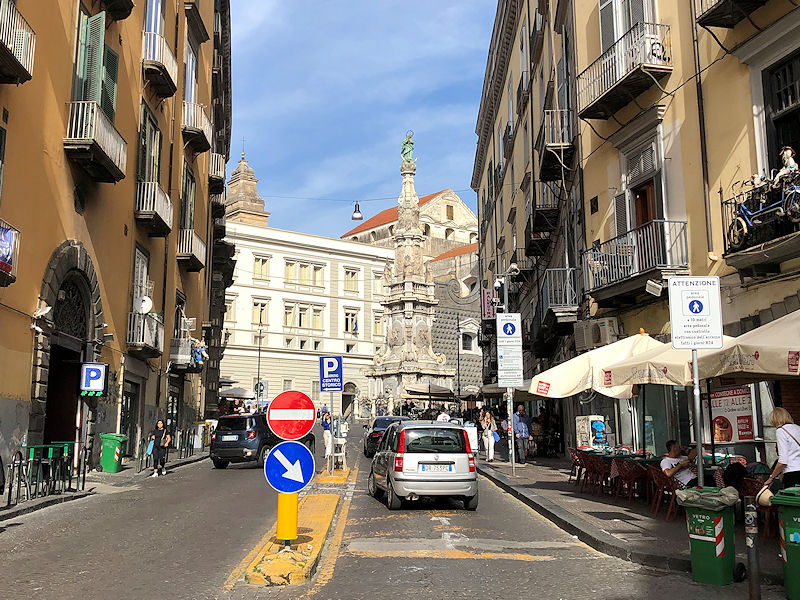
Approaching the Piazza del Gesù Nuovo, with its garish Guglia dell'Immacolata multi-statue, referred to by Google as a 'towering spire'.
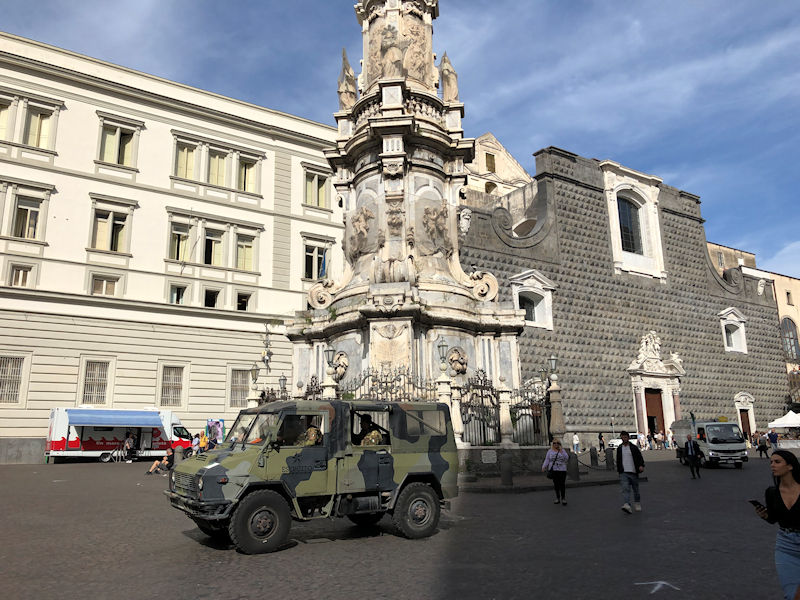
Our Operazione 'Strade Secure' protection squad is taking a short well-deserved break.
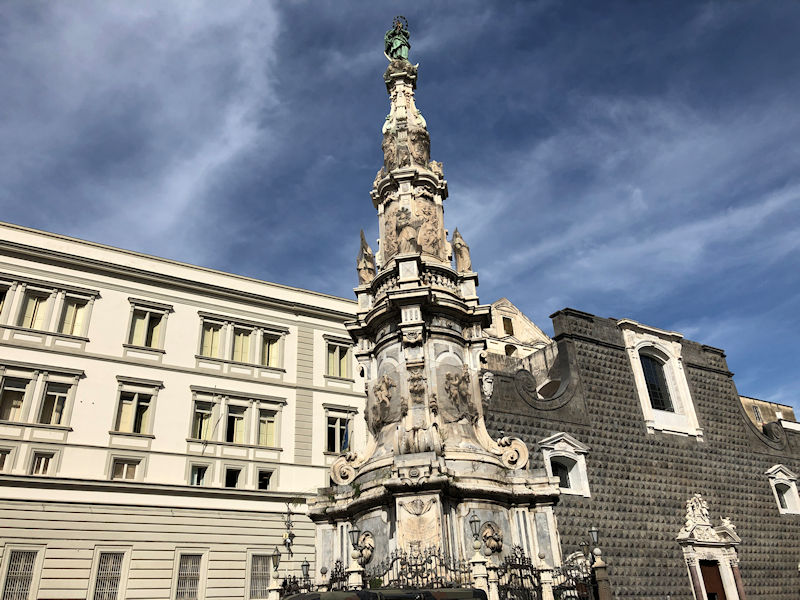
The Guglia dell'Immacolata (Spire of the Immaculate Conception) -- 'Striking 18th-century monument standing 111 ft. & featuring detailed baroque ornamentation'. No kidding!
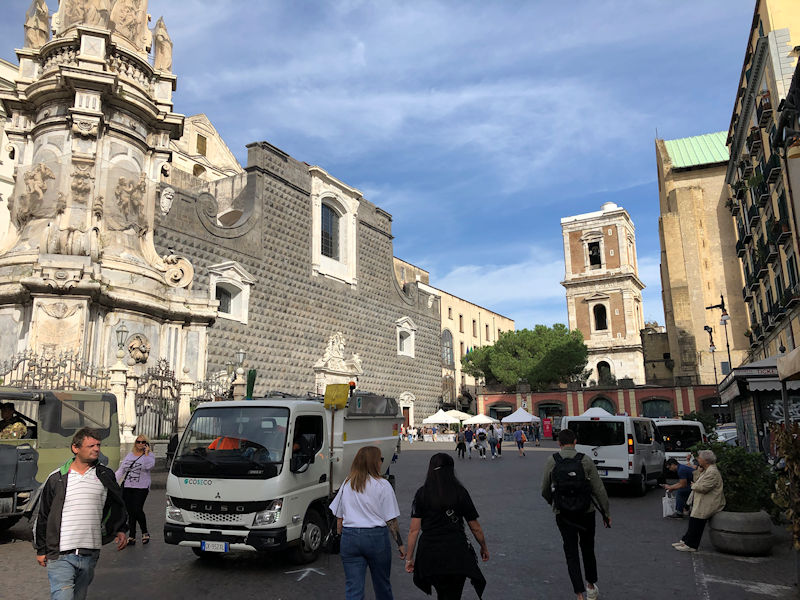
The Piazza del Gesù Nuovo and the Chiesa del Gesù Nuovo, with the grey 'diamante' façade, and bits of the Complesso Monumentale di Santa Chiara (Santa Clara Complex) peeking round from the right.
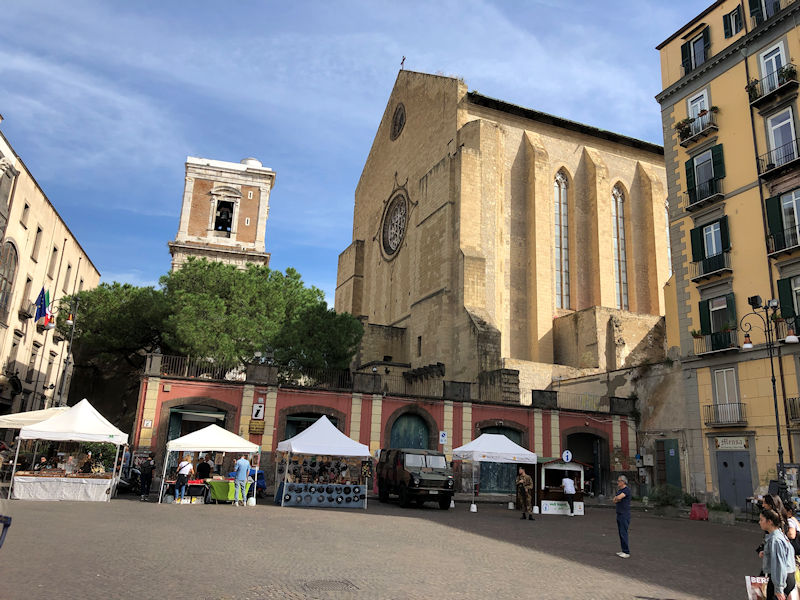
The Santa Chiara complex (we'll stop in there later; right now . . . )
The Church of Gesù Nuovo
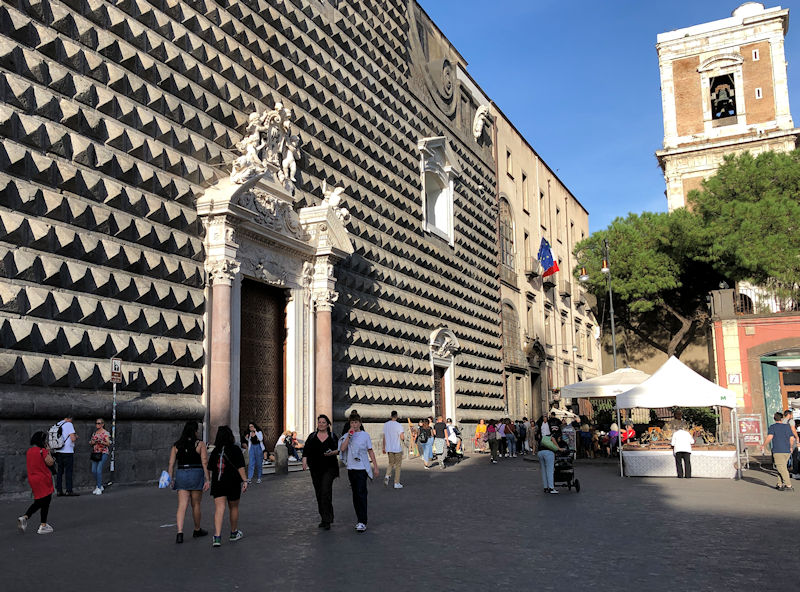
It's the Gesù Nuovo (with its diamond-shaped façade elements, reminiscent of the Diamond Palace in Ferrara).
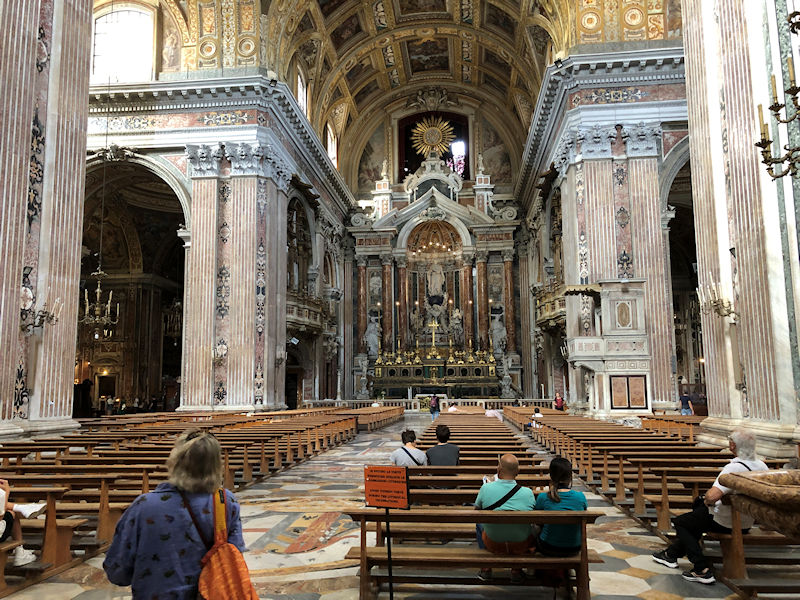
OMG! Where to start?
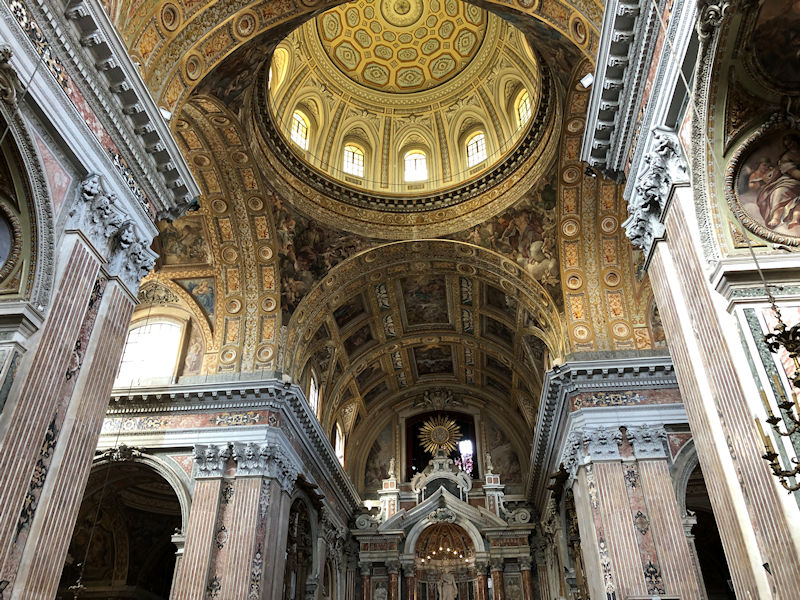
Not an inch unadorned
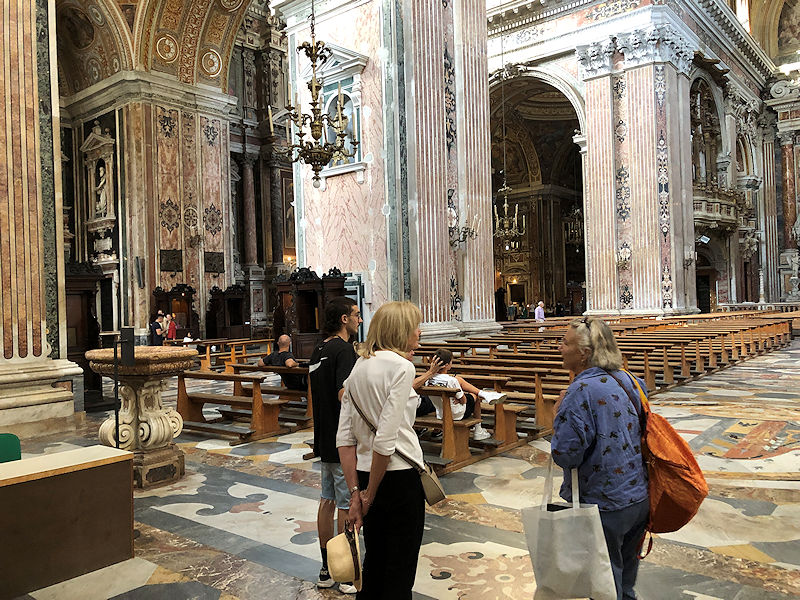
The site originally held a palace built in 1470 for the Sanseverino family, immediately outside the city limits until the expansion of the early 16th century. The property was confiscated from the unhappy family and in 1580s sold to the Jesuits, who built the church, 1584-1601, retaining the unusual façade from the palace of the 'rustic ashlar diamond projections'.
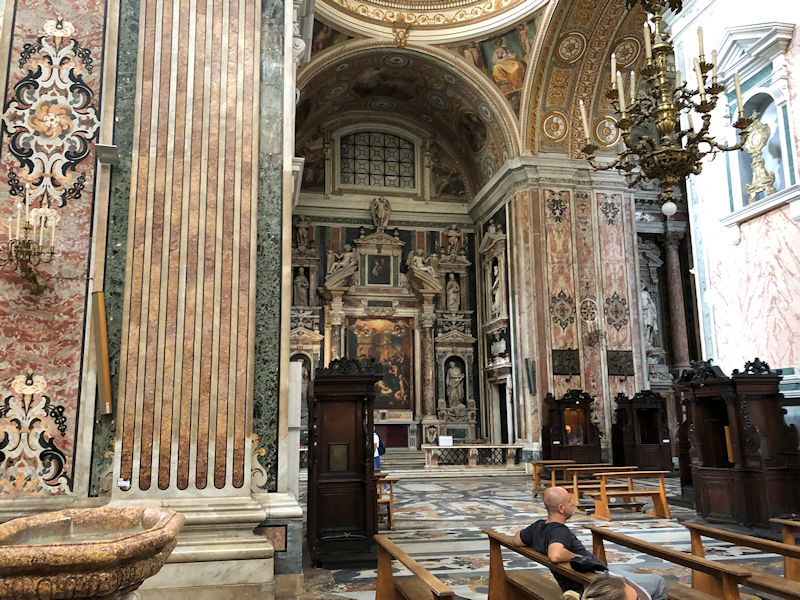
The Society of Jesus was expelled from Naples in 1767, and the church was taken over by the Franciscans. (The Jesuits came back in 1821 but were booted out again in 1848.) It's administered now by the Archdiocese of Naples.
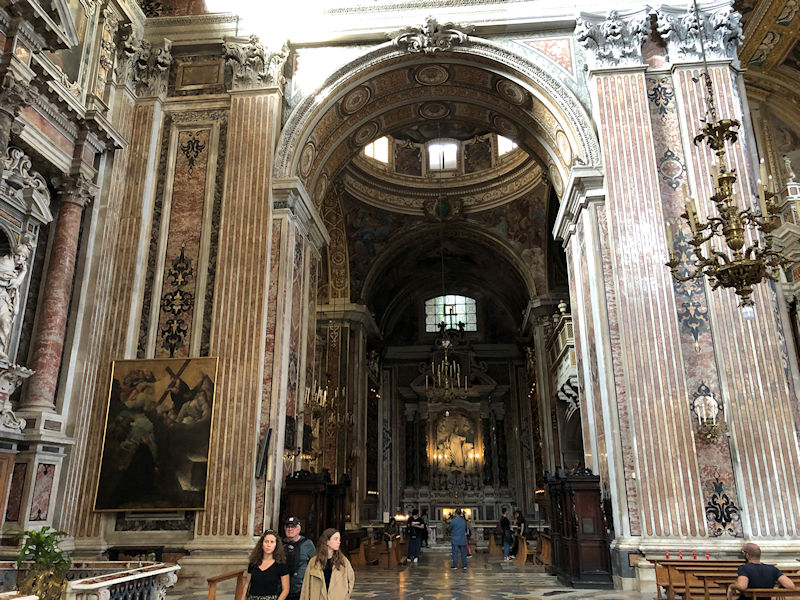
Like something from my memories of NYC's Grand Central Station in the 1950s.
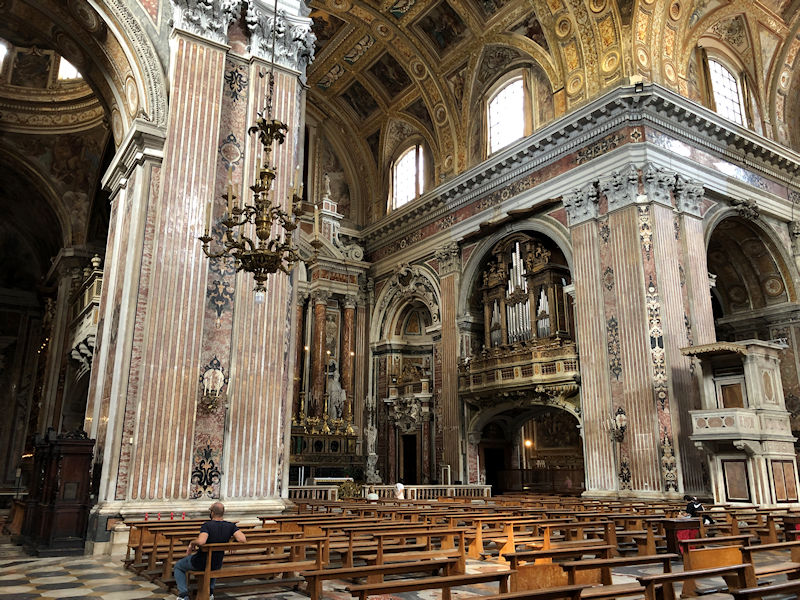
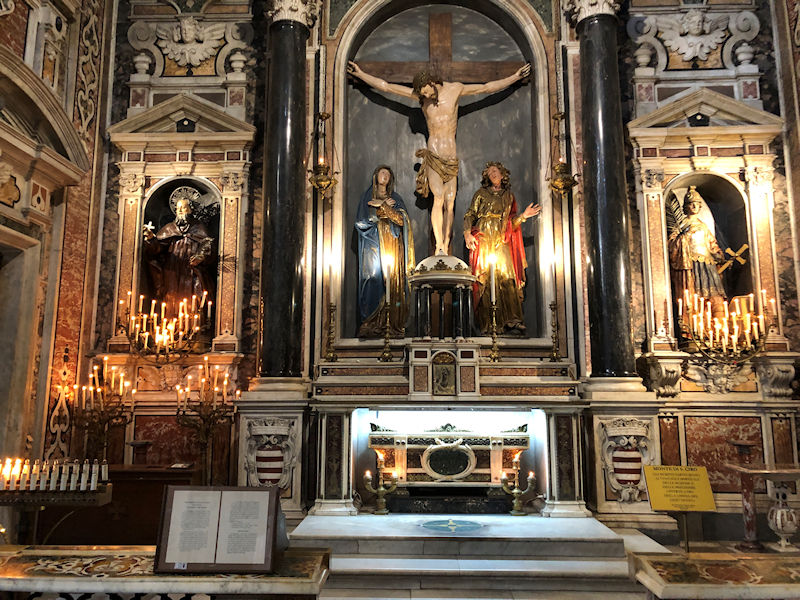
The Chapel of the Crucifix, with wooden statues of Christ, Mary, and John the Baptist [this might be a mistaken caption: they look like two babes and no Baptists]
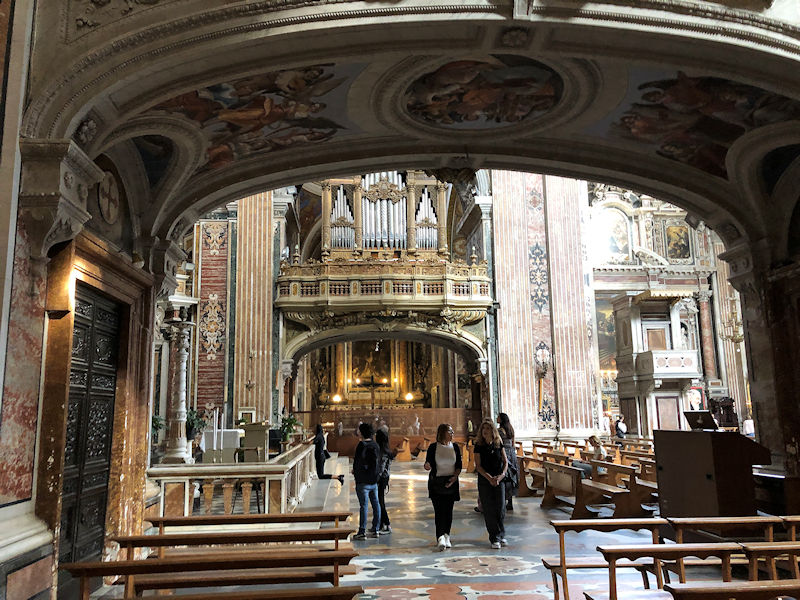
Peeking through the interstices
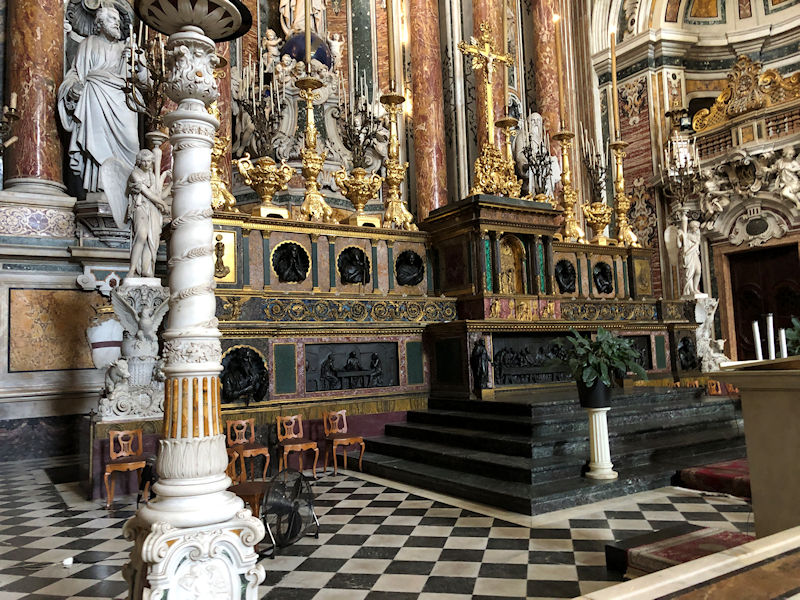
Behind the main altar
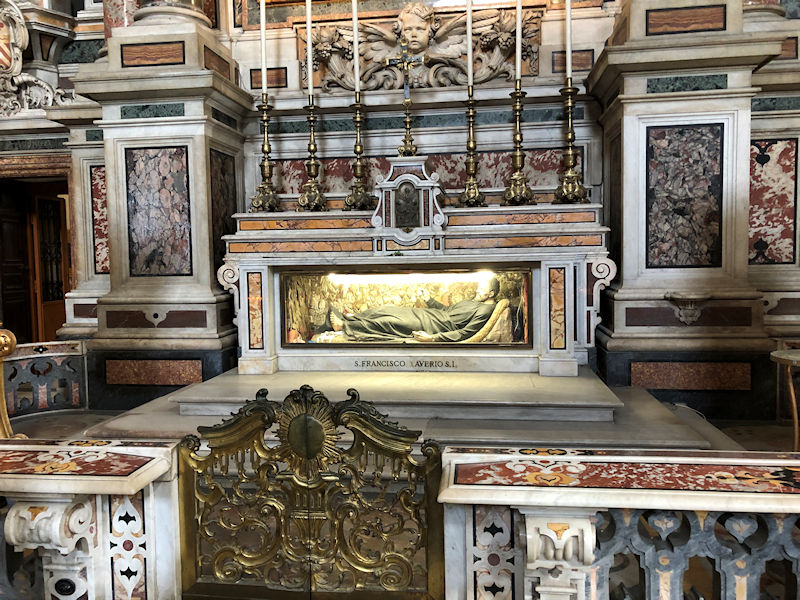
That's identified as St Francis Xavier, the Jesuit missionary, but perhaps it's a body double (since he died in China).
Next up: Across the street to the Cloisters of Santa Chiara, and then the Duomo


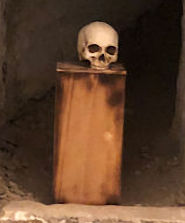 Dwight Peck's personal website
Dwight Peck's personal website













